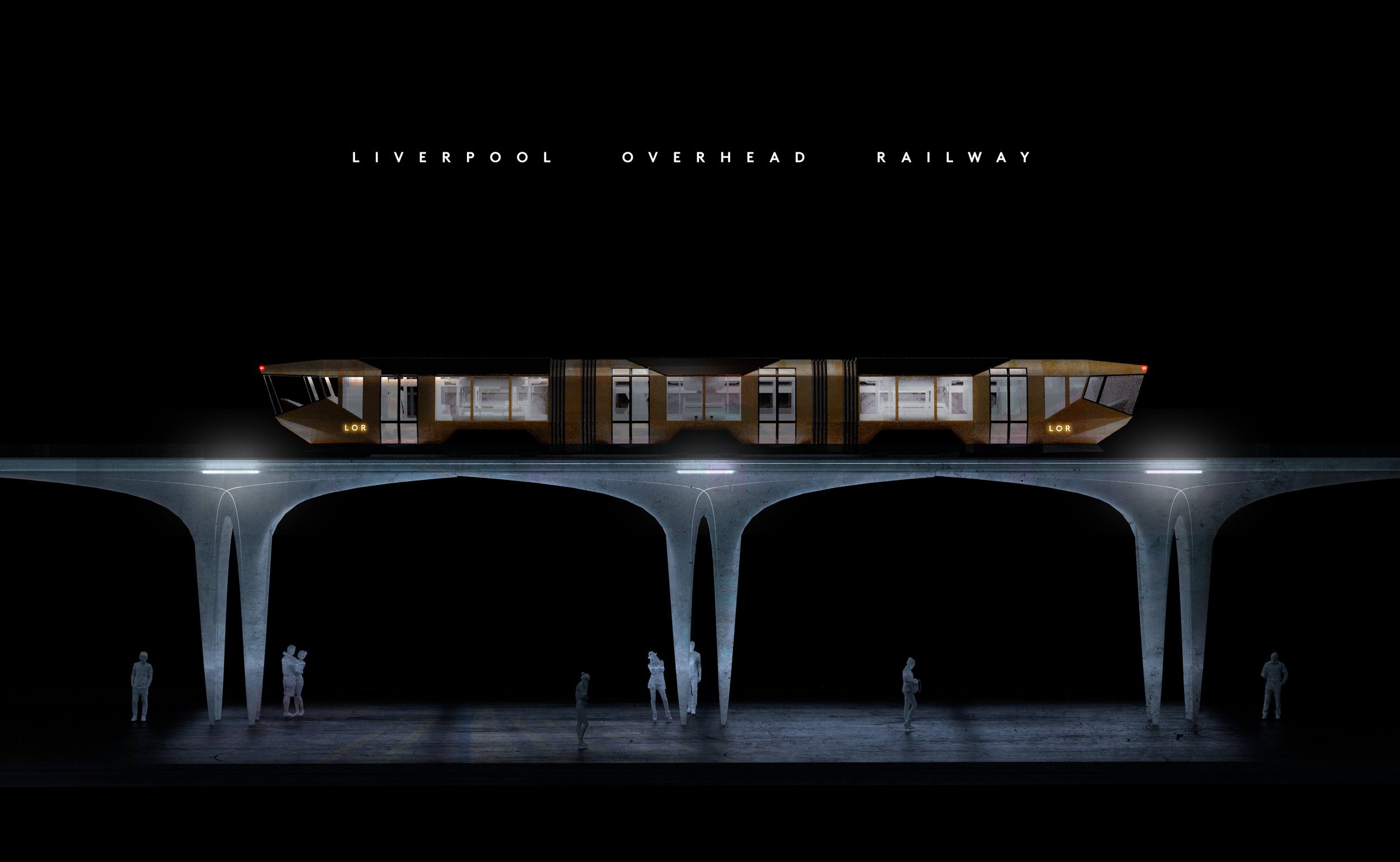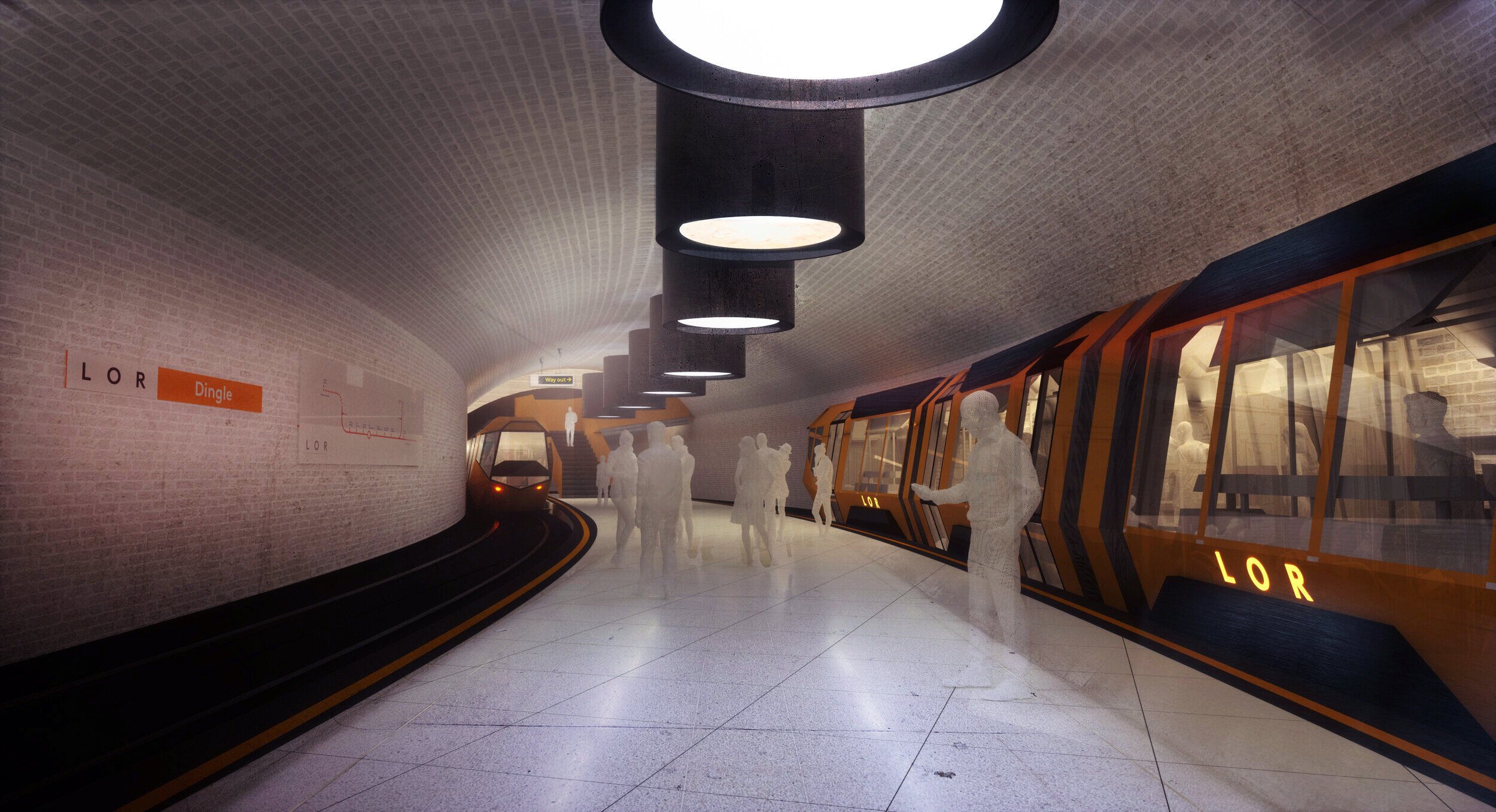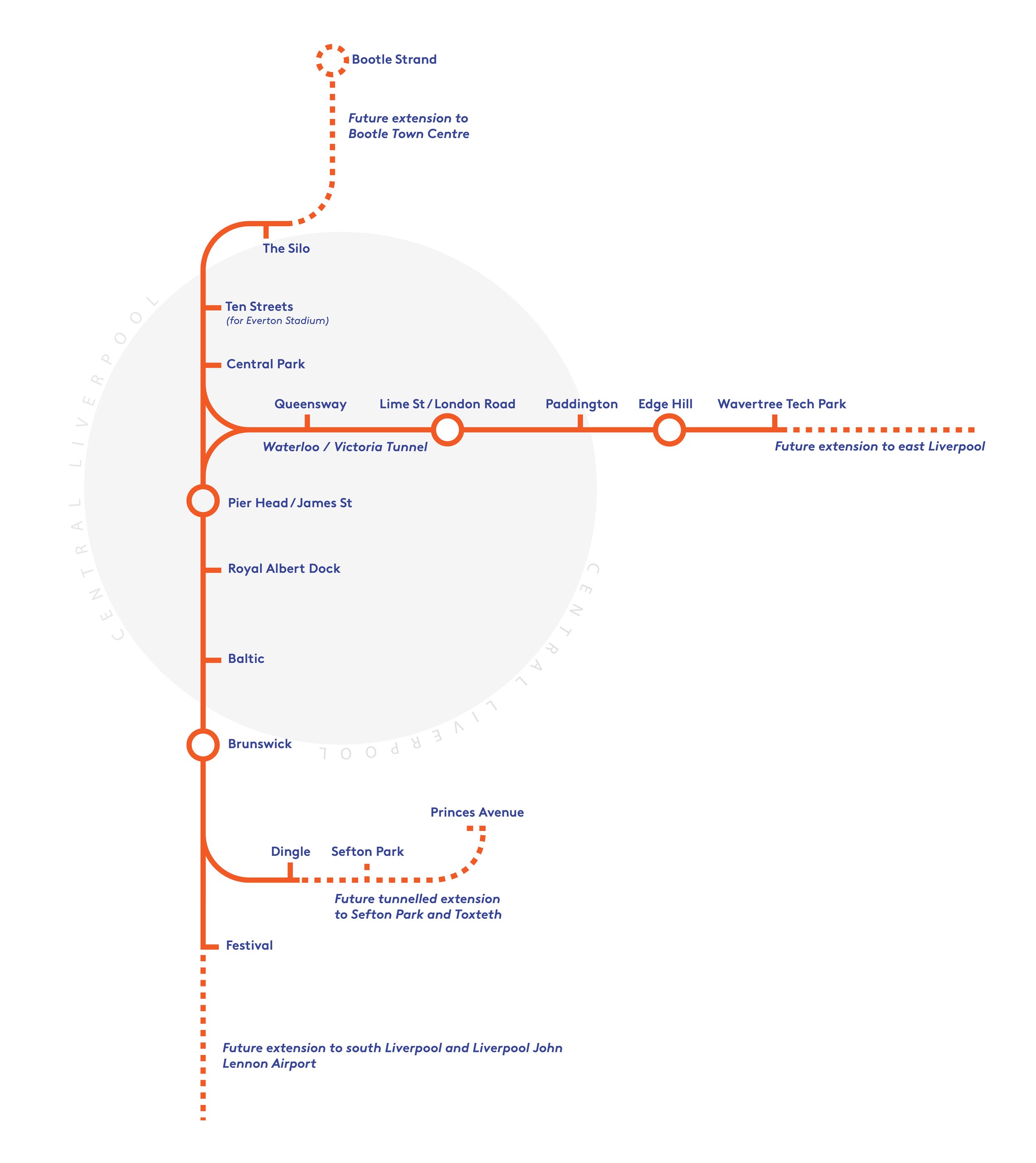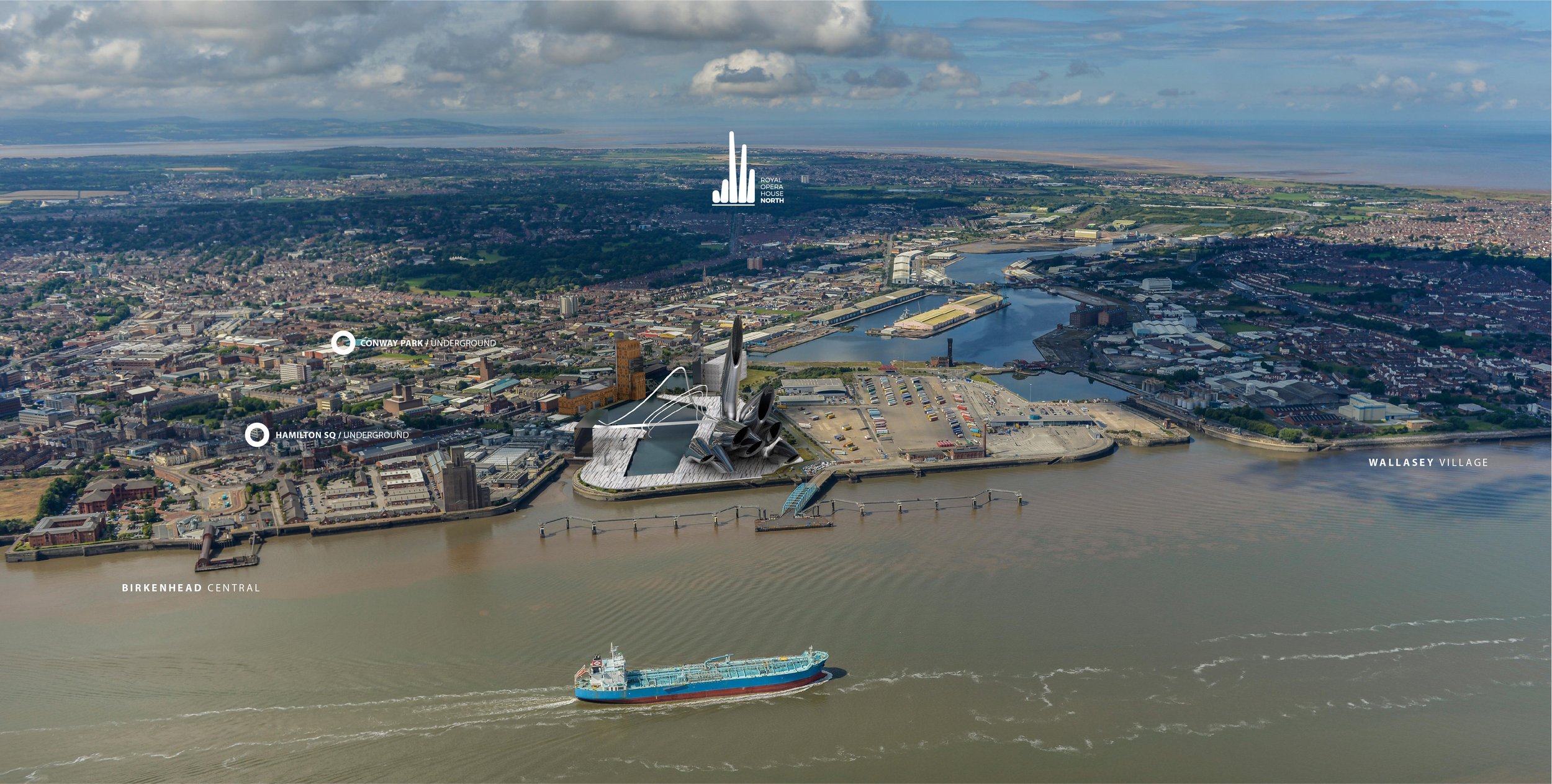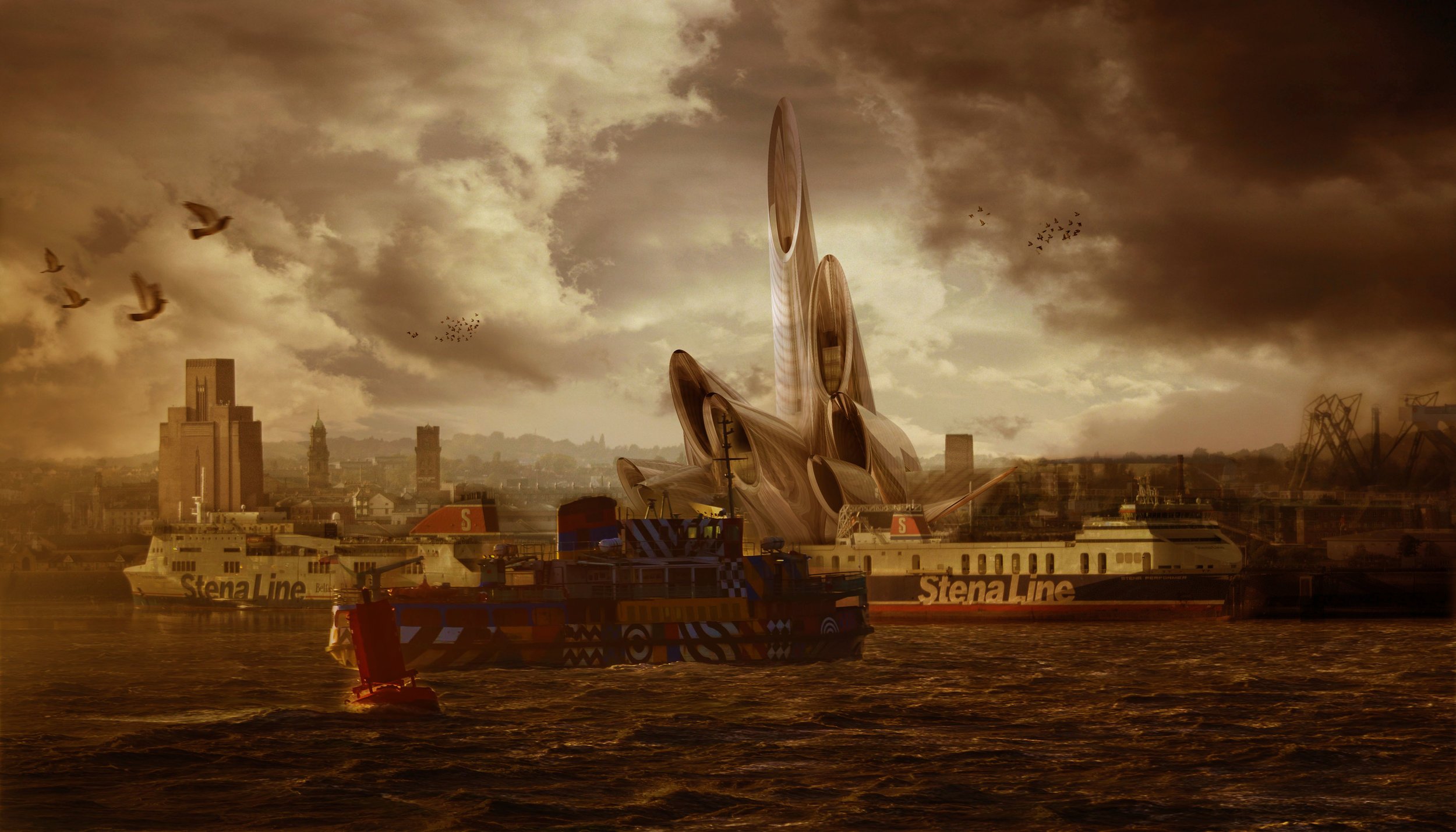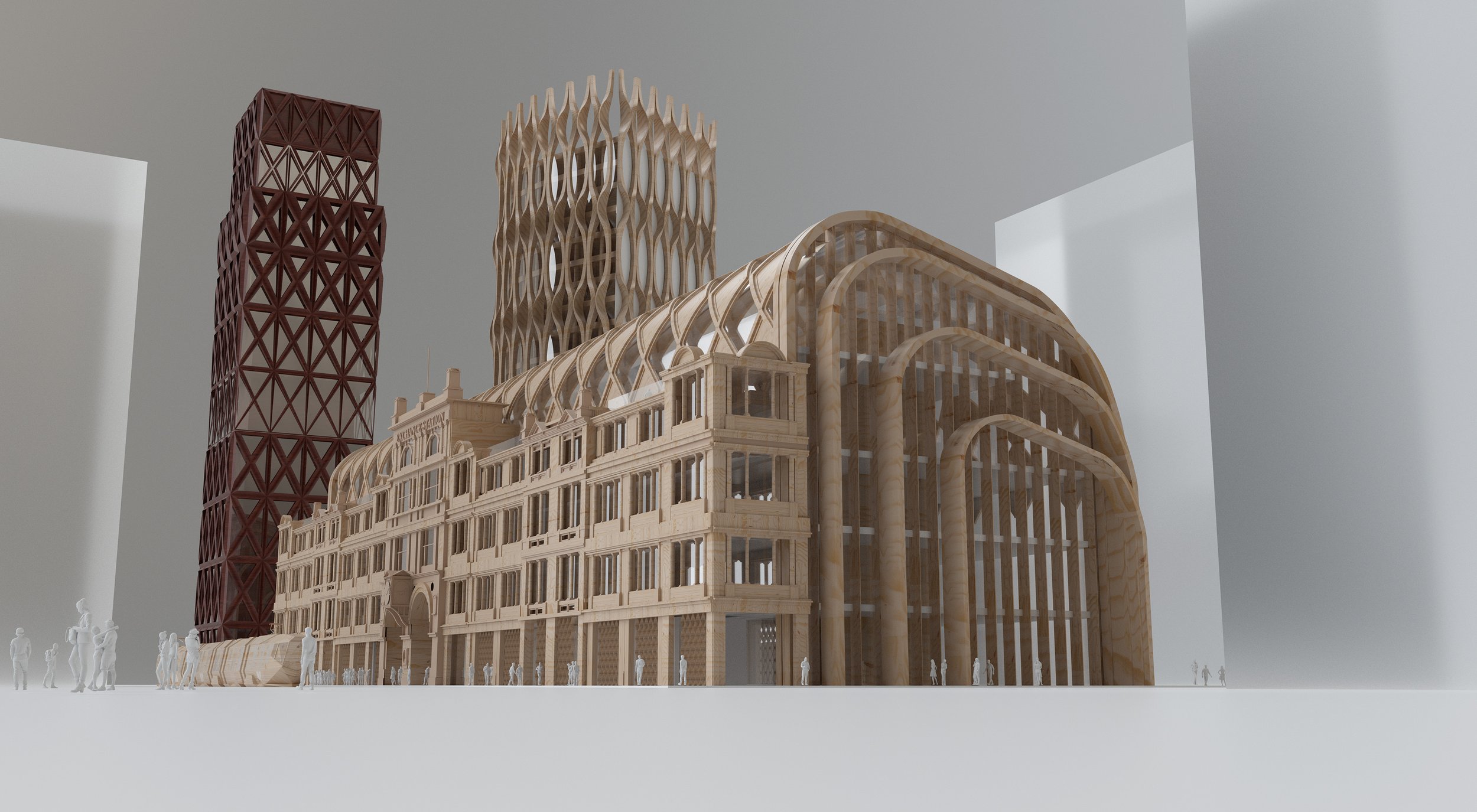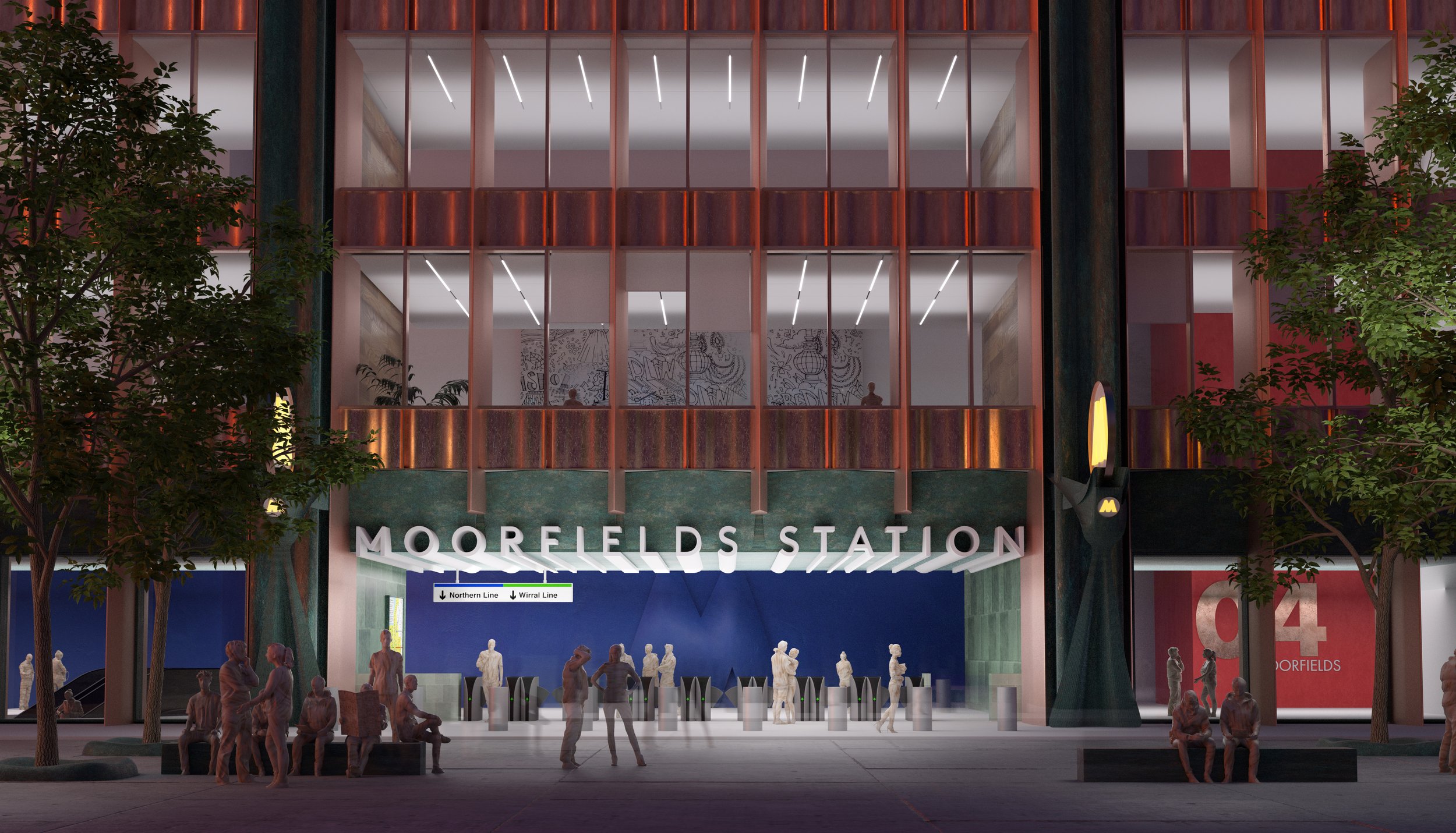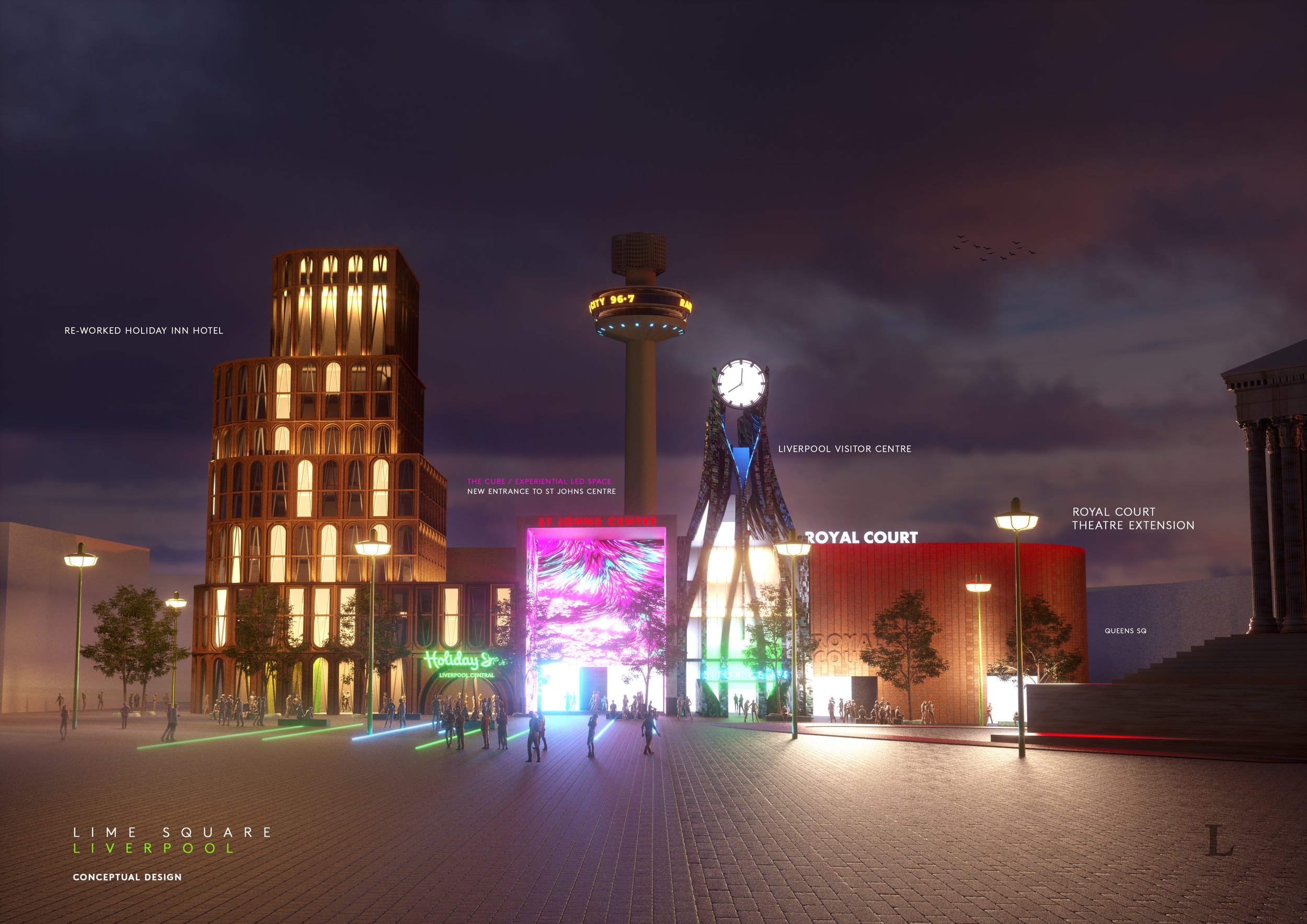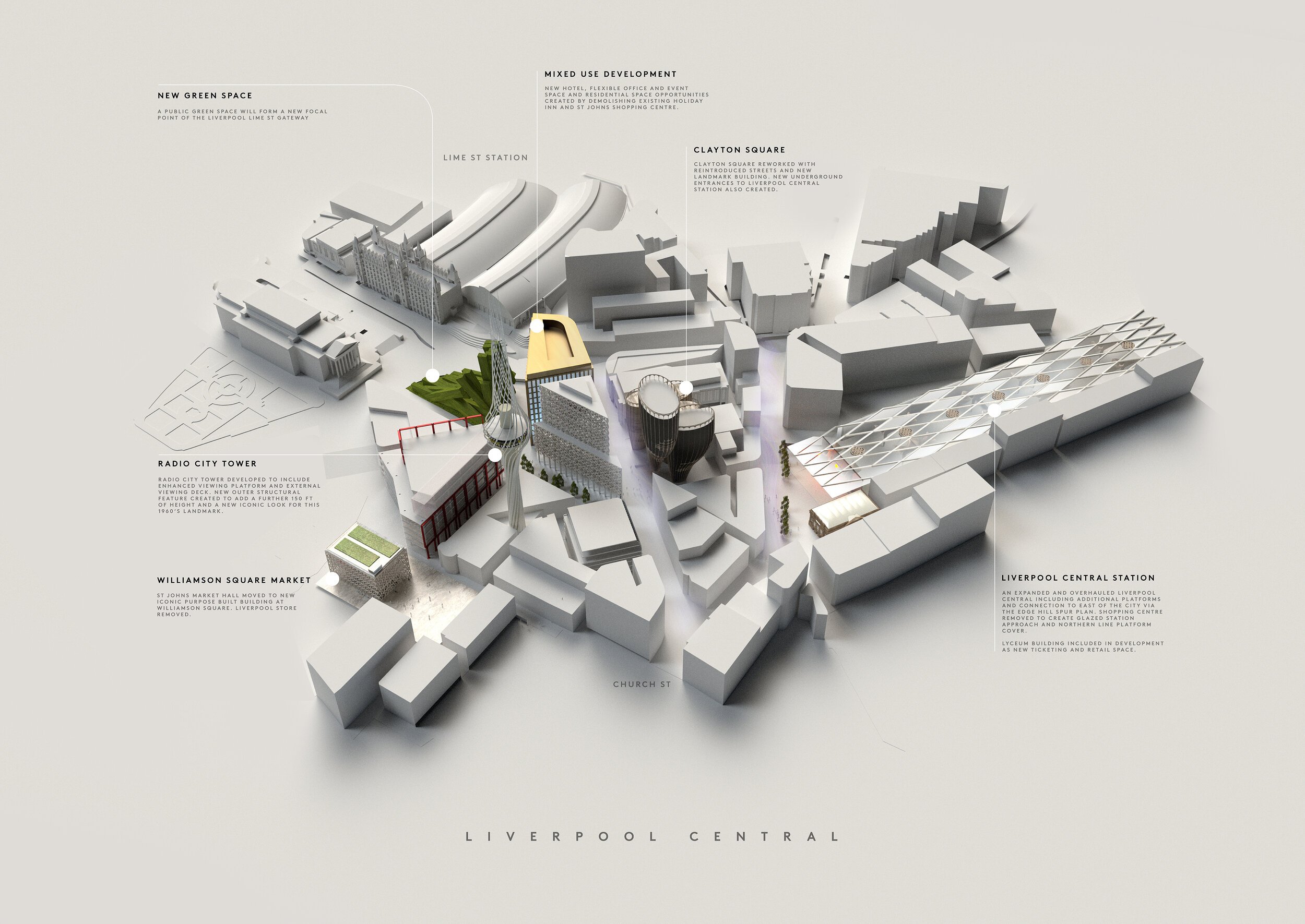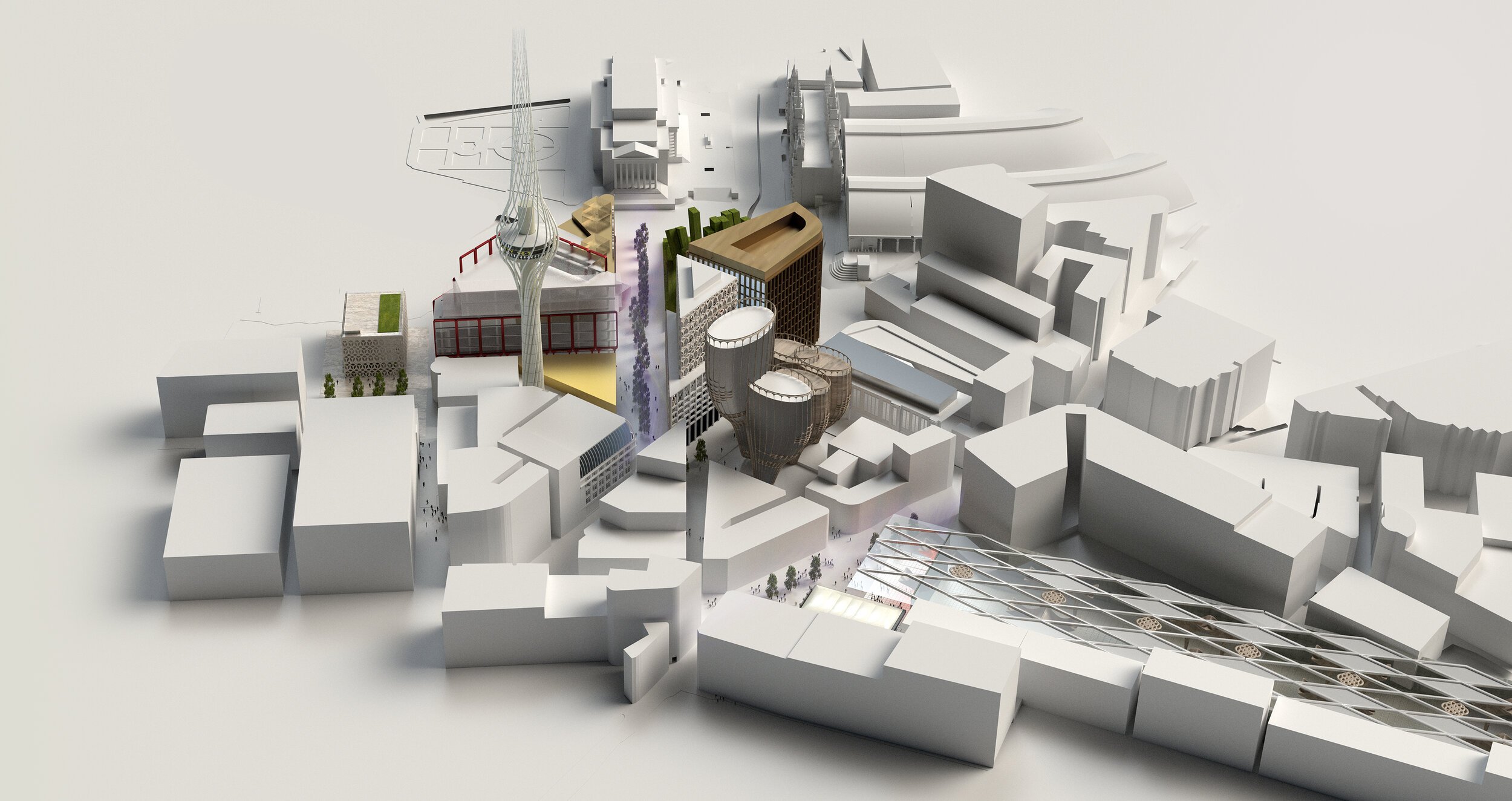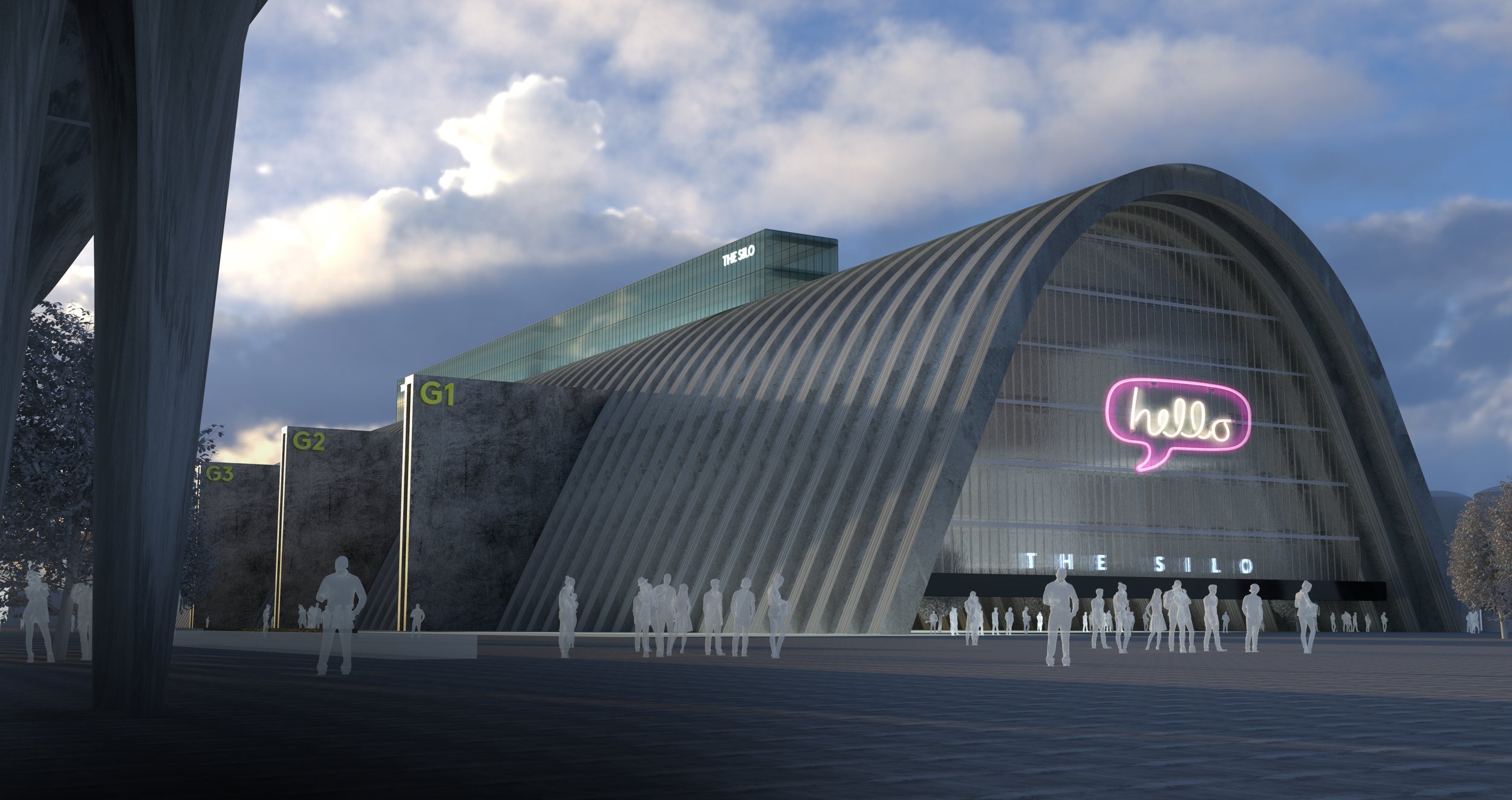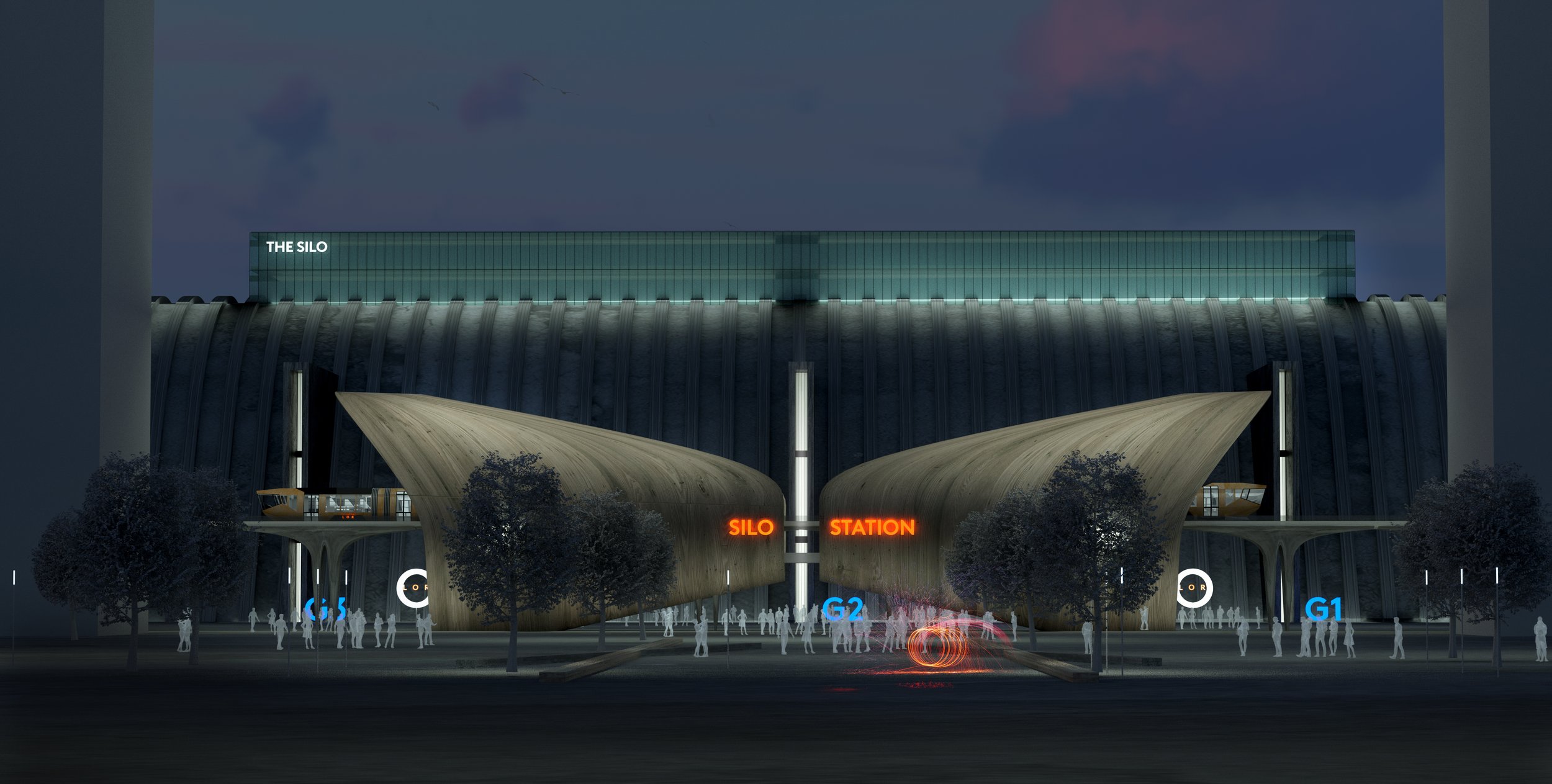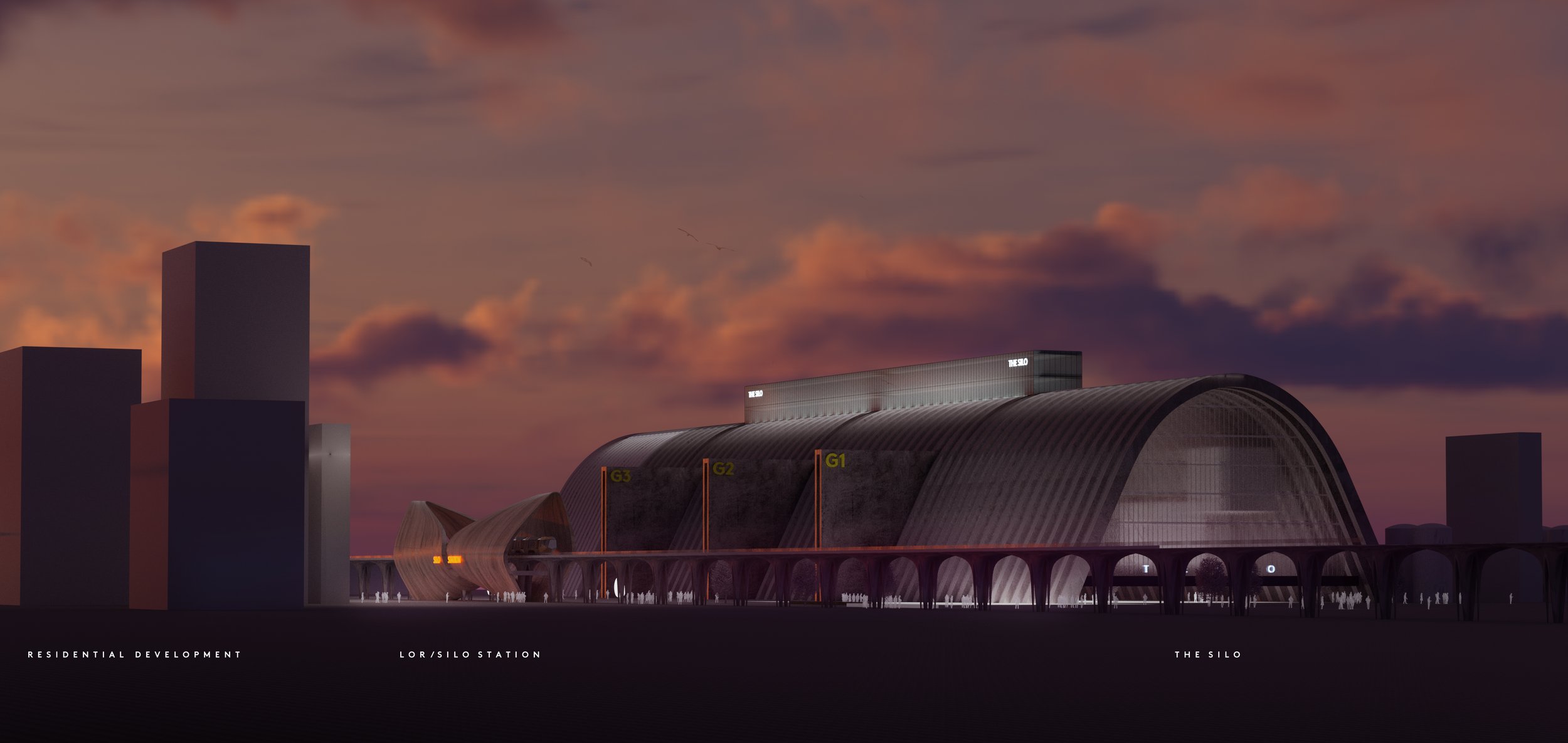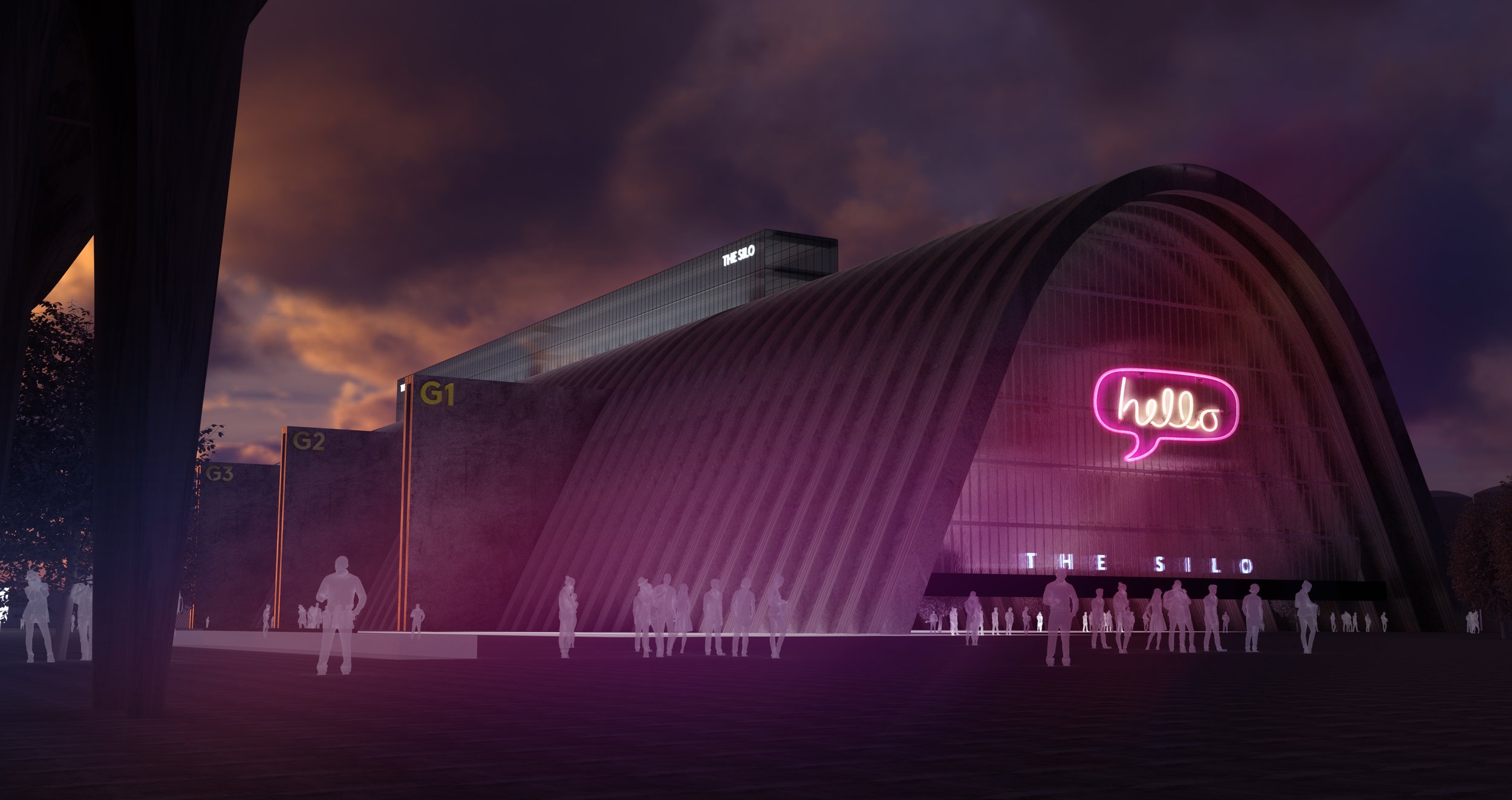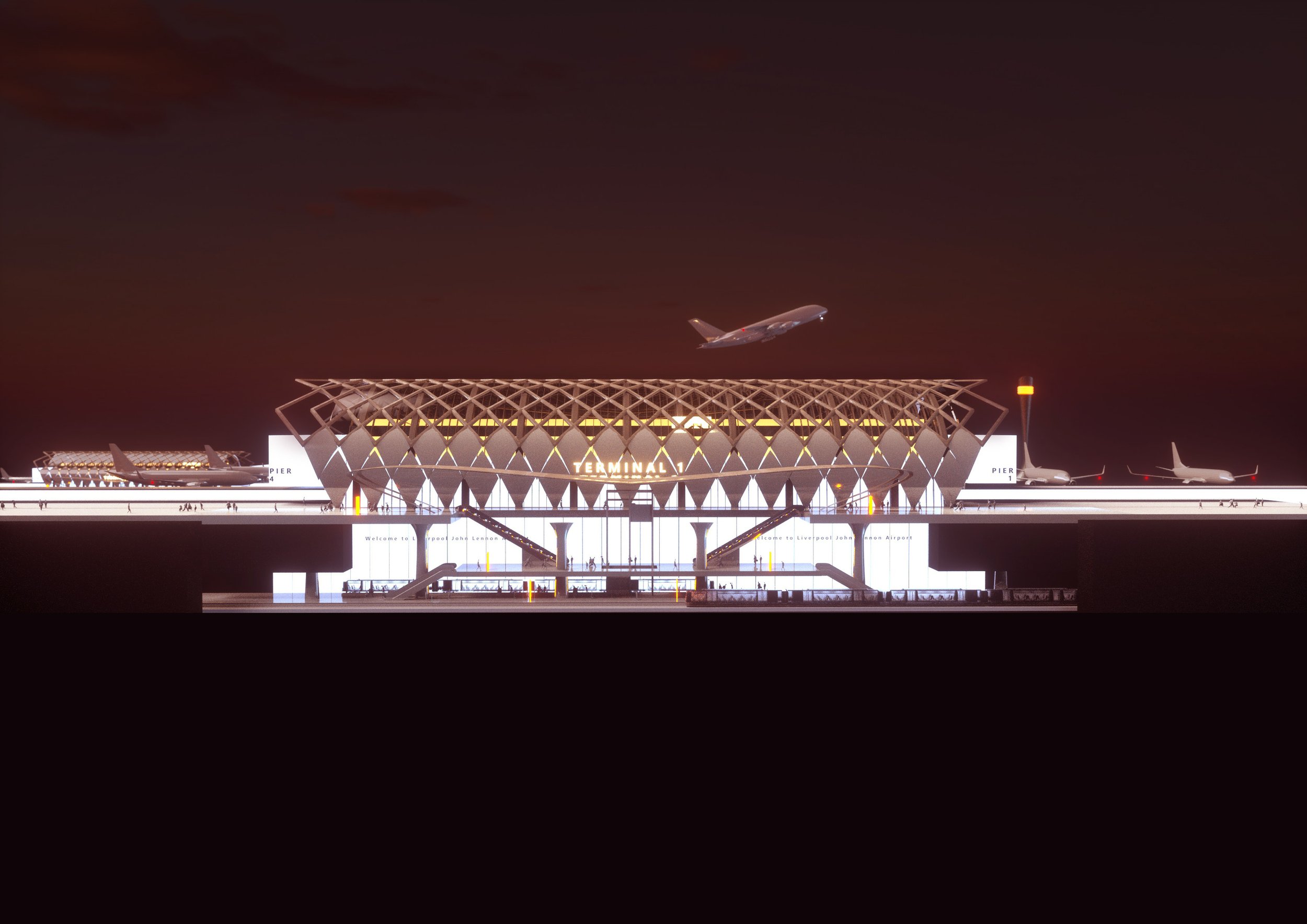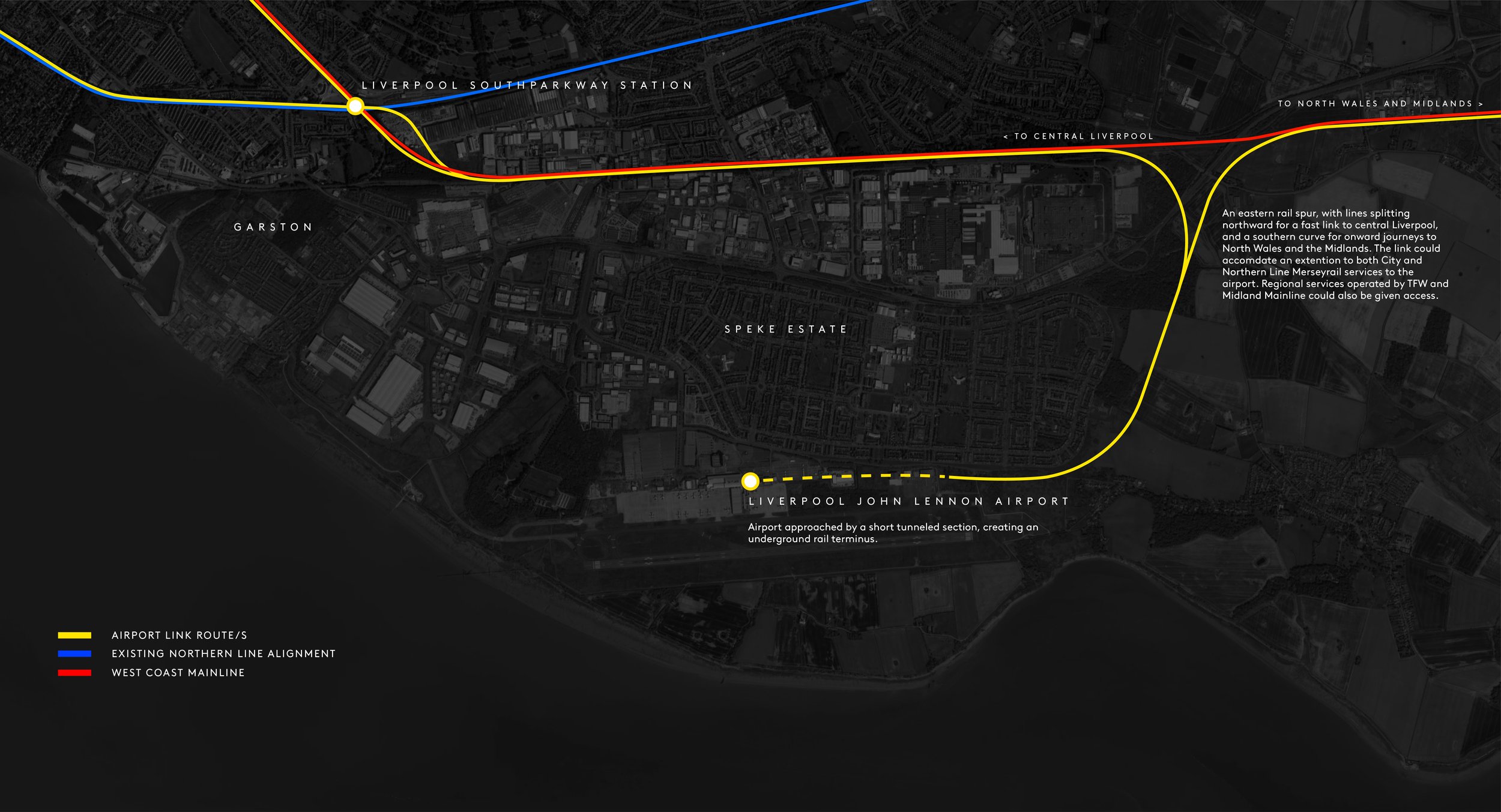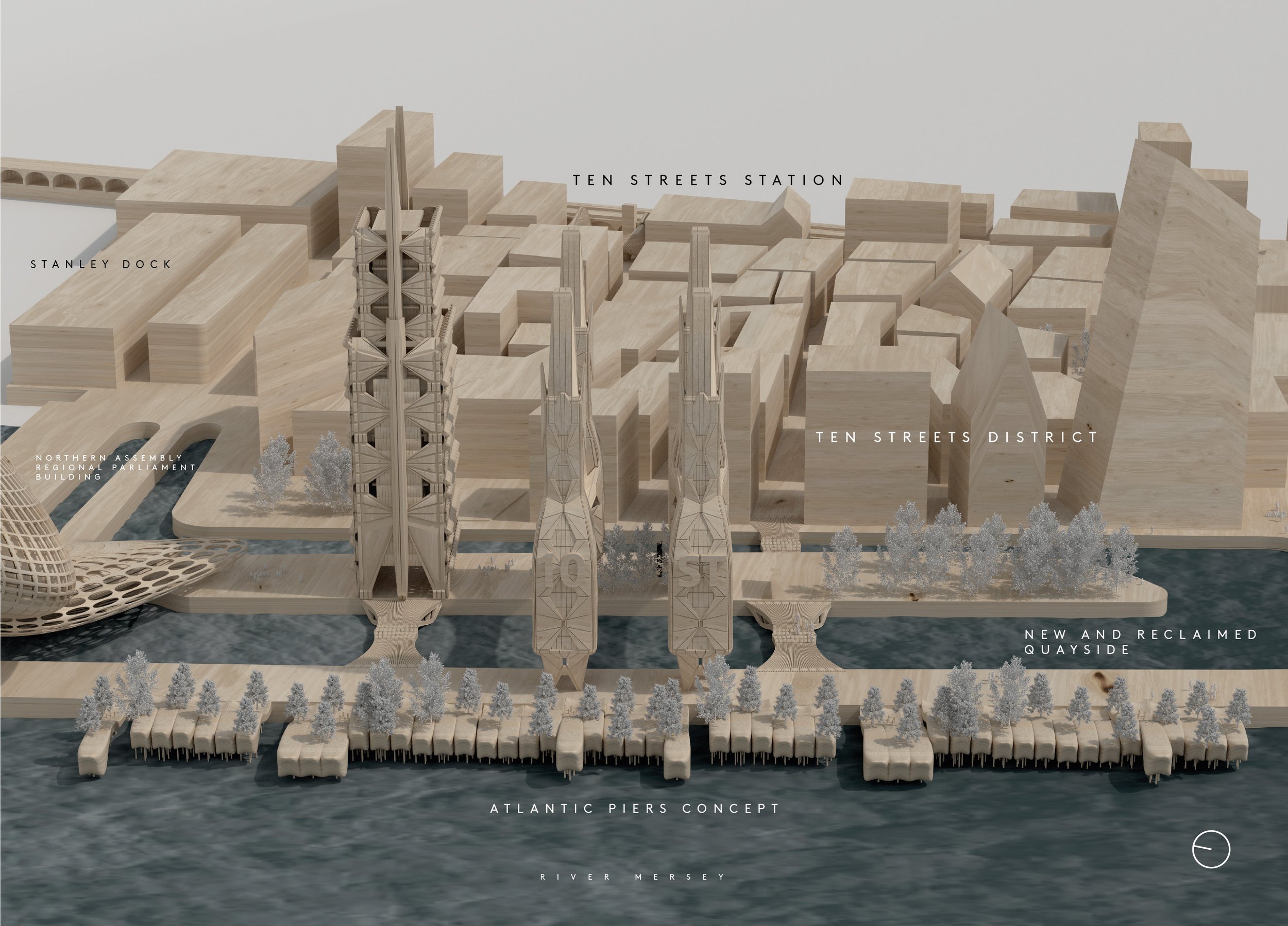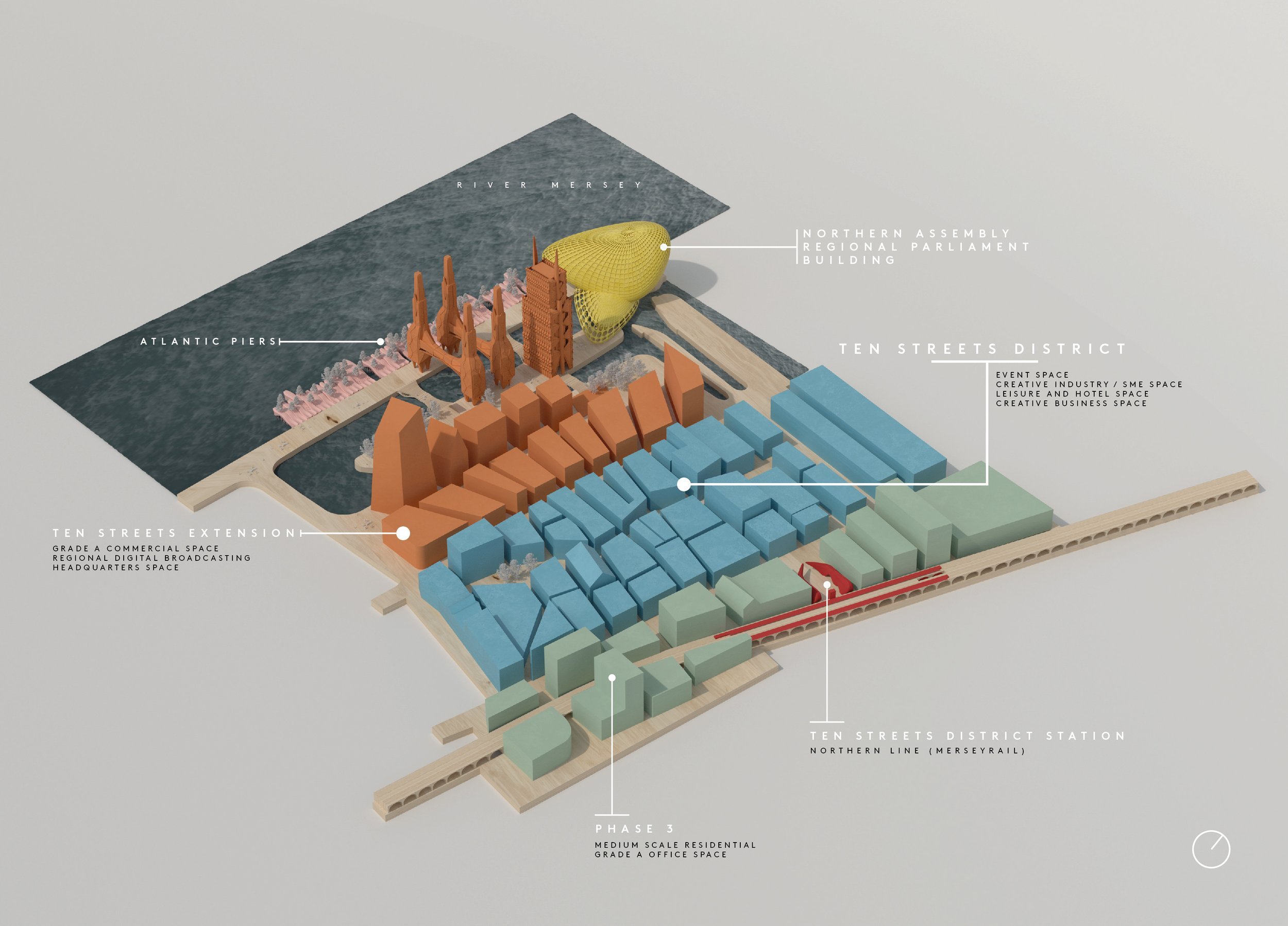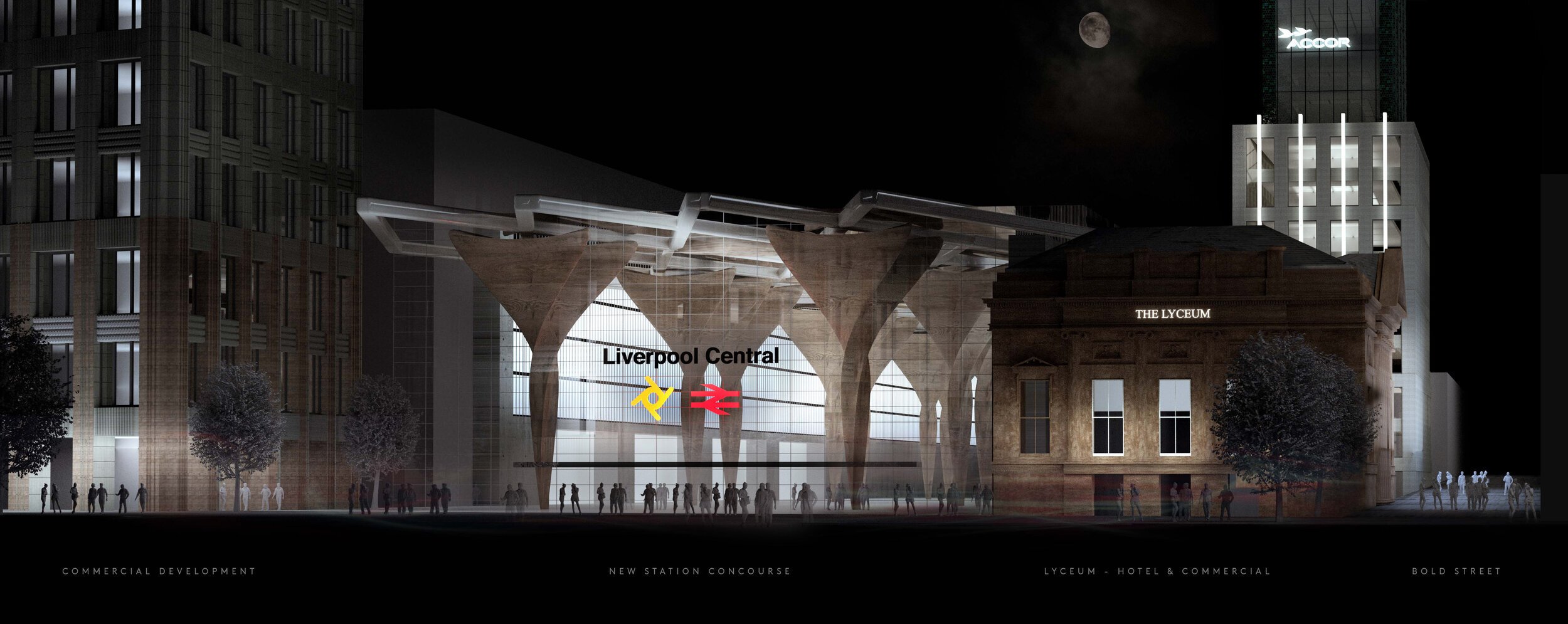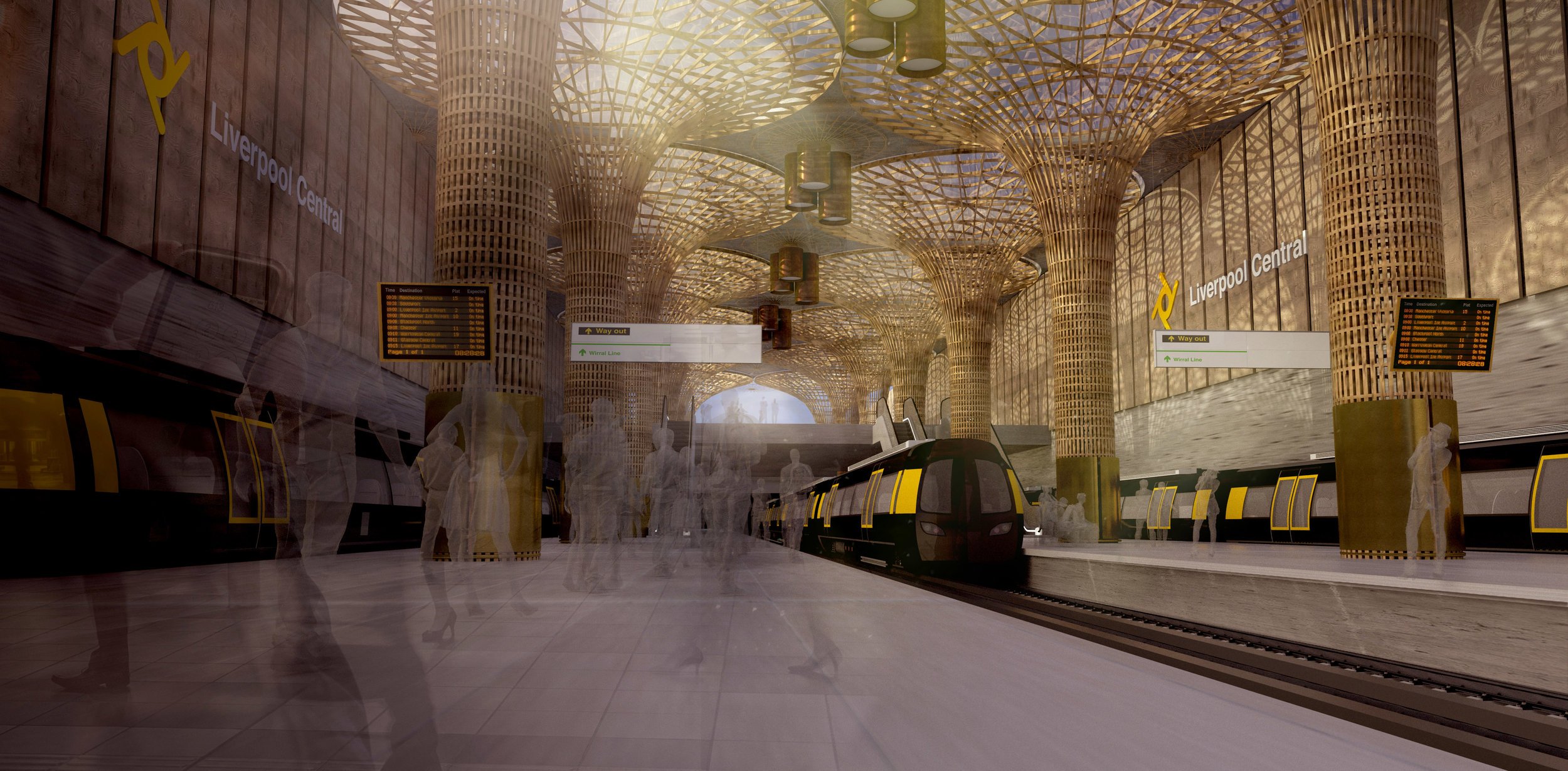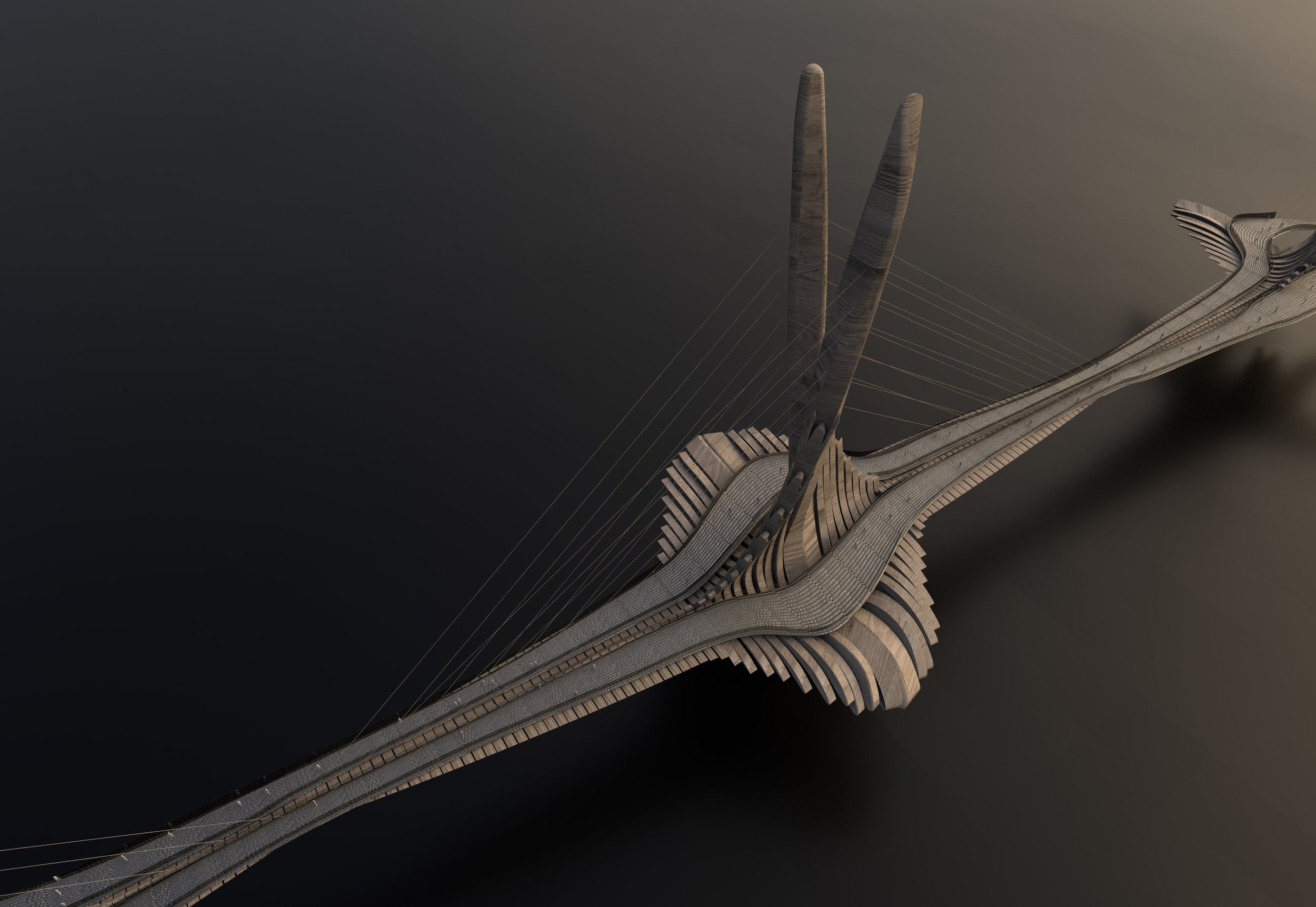Recent features
HS2 Cuts: A Second Chance for Liverpool
As we wave goodbye to any ideas of HS2 reaching the north, a deafening chorus of betrayal is drowning out attempts to assess the project’s worth more rationally. Yet the inconvenient truth is that many in the north have never been convinced of the value of HS2. In this article, Martin Sloman, a director at influential lobby group, 20 Miles More, asks whether the HS2 re-set is a golden opportunity for Liverpool - a second chance at creating new transport infrastructure that works for our city?
Martin Sloman
As we wave goodbye (at least for now) to any ideas of HS2 reaching the north, a deafening chorus of betrayal is drowning out attempts to assess the project’s worth more rationally. Yet for all that, there is an inconvenient truth displayed every time a BBC journalist puts a microphone in front of the general public - the existence of a clear disconnect between the project’s advocates and your average paying train passenger. Lord Adonis may cry foul but many in the north have never been convinced of the value of HS2. In this article, Martin Sloman, a director at influential lobby group, 20 Miles More, considers the matter from Liverpool’s perspective. He asks the question, is the HS2 re-set a golden opportunity - a second chance at creating new transport infrastructure that works for our city?
And so there it is. HS2 beyond Birmingham has gone the way of the Dodo. It is no more. It has ceased to be. It is an ex-railway.
Prime Minister, Rishi Sunak’s much trailed announcement at the Conservative Party Conference to hack back the UK’s largest public transport project represents not just a big throw of the political dice, but a huge scaling back of HS2’s ambitions. Unless you believe a Starmer-led Labour government will revive the scheme (don’t bank on it), the line will no longer extend to Manchester, instead terminating at Birmingham, the place that likes to call itself ‘the second city’. Brum’s claims have been bolstered now. This news is seen almost universally amongst the commentariat as a body blow to the much-vaunted ‘Levelling Up’ strategy, but what does it mean for Liverpool and our city region? Should we see it less as a disaster for the north and more as a second chance to get our city’s transport infrastructure right?
Liverpool came late to the HS2 debate. It was only after the Phase 2 proposal was revealed in January 2013 that we began to realise how the project would affect us. By then, the route was set in stone, and it didn’t look good. The new line was designed as if Liverpool didn’t exist. There would be stations at Manchester Piccadilly and Manchester Airport, a lengthy tunnel into Manchester city centre and a link to the north via Wigan. Liverpool would be lucky to get new, plastic platform seating.
Under the HS2 plan, its high speed trains would run from Liverpool to London but would first need to traverse almost 40 miles of Victorian railways at slower speeds before accessing new, gleaming track south of Crewe. The Liverpool service would be limited to the shorter 200m ‘classic compatible’ trains with half the seats and would run two services per hour with a running time to London of one hour and 34 minutes. Meanwhile, Manchester would receive the gold-plated service - three 400m double-length ‘captive’ trains per hour, speeding to the capital in one hour and 8 minutes – three times Liverpool’s capacity and 28% faster – the end of historic parity in connections to the south.
The lack of high-speed infrastructure to serve Liverpool would prevent the release of capacity on our existing local network, which was supposed to be one of the selling points of HS2. This would severely limit the development of new passenger and freight services and ran contrary to the recommendations of ‘Rebalancing Britain: Policy or Slogan?’ – the Heseltine / Leahy report of 2011 which stated:
‘Government should amend the currently proposed High Speed 2 route, so it connects to both Manchester and Liverpool directly. In the same time frame and to the same standard, Government should commit to assuring Liverpool’s historic parity with Manchester for travel time to London and thereby avoid harmful competitive disadvantage to Liverpool in attracting inward investment’.
That harmful competitive disadvantage was confirmed by accounting giants KPMG who produced their report – HS2 Regional Economic Impacts on behalf of HS2 in 2013. It showed maps of Britain covered in big green circles, where HS2 would uplift the economy of cities and towns. There were, however, little red circles and they were less good news and one of them was over Liverpool. To be fair, the report claimed Liverpool’s GDP could be uplifted by 1.2% in ‘favourable’ conditions, but equally it could shrink by 0.5% in ‘unfavourable’ ones. Not exactly a ringing endorsement and a worse outcome than for towns and cities that were not even connected to the network in any way, such as Hull.
In response to this threat, a coalition of academics and local business figures led by Andrew Morris banded together to form 20 Miles More, an independent campaign group lobbying for a direct, dedicated link to HS2. The 20 miles referenced in the name referred to the length of the shortest link to the HS2 network. Our group, of which I was a director, produced reports, met with political, business and transport leaders and responded to consultations. The assistance of political consultants Jon Egan and Phillip Blond helped us to secure television coverage for our launch event.
Something must have stirred because not long after the Liverpool City Region Combined Authority and the local councils woke up to the danger and launched their own campaign called Linking Liverpool and we’d like to think we had something to do with that. They calculated that a direct Liverpool link to HS2 would be worth £15 billion to the local economy and secure 20,000 new jobs. At last, the issue facing our city was being taken seriously.
“That harmful competitive disadvantage was confirmed by accounting giants KPMG. Their report showed maps of Britain covered in big green circles, where HS2 would uplift the economy of cities and towns. There were, however, little red circles and they were less good news and one of them was over Liverpool.”
One point that we made in our report was that a Liverpool link to HS2 could form part of a new rail link to Manchester and over the Pennines to Leeds. We felt vindicated when the Northern Powerhouse Rail initiative was launched in 2014. This envisaged six northern cities – Liverpool, Manchester, Leeds, Hull, Sheffield and Newcastle being linked by new high speed rail infrastructure. This resonated with Boris Johnson’s ‘Levelling up’ agenda.
In 2020, construction work on the first phase of HS2 (London to Birmingham) started and the realities began to strike home. The prospect of miles of countryside being torn up for a new railway generated local opposition and the wrath of environmental groups, especially in the home counties, but it was the rapidly escalating cost of the project that really concentrated minds. An initial 2010 estimate of £33 billion had now ballooned to £71 billion with some commentators suggesting the final figure could be well over £100 billion.
Why costs spiralled out of control may be down to a number of reasons – overspecification of the initial project, inflation, procurement issues, planning delays, environmental mitigation, and of course, government interference. The result was cutbacks and delays, culminating in Rishi Sunak’s announcement at the Tory’s Manchester Conference – bad news for ‘the north’ delivered in the self-declared heart of ‘the north’, eyeball to eyeball.
Figure 1
Routes and phasing of HS2 as they stand following Sunak’s recent announcement.
Looking at the map, what Sunak has done is to prune HS2 back to Phase 1, which runs from London to Birmingham. Gone is Phase 2a from Birmingham to Crewe, Phase 2b (East) from Birmingham to East Midlands Parkway and Phase 2b (West) from Crewe to Manchester. What has been retained is the link from London Euston to Old Oak Common (reportedly now subject to finding private sector investment) – vital for delivering an effective HS2 service – as well as the link at Lichfield (Handsacre) junction to the existing West Coast Main Line, which allows trains from Liverpool and Manchester to make use of HS2.
The implications for the North West are significant and on the upside, the damaging inequality between Liverpool and Manchester identified by Heseltine and Leahy has been removed. So, from the completion of Phase One (currently scheduled for some time between 2029 and 2033), both Liverpool and Manchester will have services to London making use of existing tracks as far as Lichfield. Trains will run on HS2 for over 60% of the distance from London to the North West with the remainder of the journey on the much slower classic network. That will give a journey time to Liverpool of around one hour and 46 minutes and to Manchester of one hour and 41 minutes. This five-minute difference contrasts with the 26-minute difference that would have occurred had Phase 2b gone ahead. Liverpool’s train capacity will be unaffected, remaining at two 200m long units per hour (each carrying up to 550 passengers) - whereas Manchester will see a halving of its promised capacity to three 200m units. This is because the 400m long, 1100 passenger ‘captive’ trains (trains that can only run on the new HS2 route) that were to serve Manchester under the original plans can no longer do so.
“It is difficult to support a proposal that would deliver so little to our city and so much to a city that is an economic rival.”
The reduction in overall train capacity and increase in journey time is, of course, a body blow to the North West and has resulted in accusations of betrayal in certain quarters. But while the avoidance of baked-in disadvantage between our two cities might provoke a sigh of relief in some, it would be wrong to assume that what is bad for Manchester must be good for Liverpool. As Jon Egan pointed out in his recent Liverpolitan article, Mancpool: One Mayor, One Authority, One Vision, the real disparity is not so much between Liverpool and Manchester but between the two cities and London. However, it is difficult to support a proposal that would deliver so little to our city and so much to a city that is an economic rival.
Rethinking Northern Powerhouse Rail
Another victim of the latest cuts is Northern Powerhouse Rail. This body is to be replaced by a new entity known as Network North and improved journey times are promised from Manchester to Bradford, Sheffield and Hull with £12 billion allocated to a link between Manchester and Liverpool. How that money is to be spent will be the subject of agreement between our civic leaders (and presumably other North West towns such as Warrington).
Northern Powerhouse Rail envisaged high speed lines linking the main cities of the North West. However, when the Department of Transport published the Integrated Rail Plan (IRP) in 2021, these aspirations were somewhat diluted.
Figure 2:
The Integrated Rail Plan (2021) - not so integrated now
“What does all this mean for that ring-fenced £12bn route between Liverpool and Manchester? Will there still be a requirement for the Manchester Airport tunnel? Budgeted around the £5bn mark (before inflation hit) that would take a hefty chunk out of the available cash.”
According to the IRP plan, the Liverpool to Manchester rail route would be achieved by a mixture of upgraded freight and passenger lines, some new construction and the Manchester branch of HS2.
This arrangement was never optimum – being seen as a ‘bolt-on extra’ to HS2. However, it did directly connect Liverpool to the new rail network allowing a London connection to HS2 via Tatton Junction.
Changes were made to the IRP routing following the publication of Sir Peter Hendy’s Union Connectivity Review in November 2021. Hendy identified that the best way of increasing passenger and freight capacity to Scotland and Northern Ireland (via the Port of Liverpool) was by upgrading the existing West Coast Main Line north of Crewe.
The proposed route of HS2 to the North – the ‘Golborne Spur’ to the east of Warrington - was subsequently deleted and a review put in place to determine an alternative route that better met the aspirations of the Hendy report. This is, for now, clearly off the agenda.
So, what does all this mean for that ring-fenced £12bn route between our cities? Will it stay the same or once again morph into something else? Certainly, this is an opportunity to completely rethink the Liverpool to Manchester link. For example, will there still be a requirement for the Manchester Airport tunnel? If so, budgeted around the £5bn mark (before inflation hit) that would take a hefty chunk out of the available cash – although it is difficult to see how else a new link can be run into central Manchester. However, given that there is no longer a need to accommodate HS2, strictly speaking there’s no reason why an improved alignment can’t be sought. But there may be other ways to spend the money.
A Mersey Crossrail?
Prime Minister Sunak has promised that the £36 billion ‘saved’ by the cancellation of HS2 Phase 2 will be re-invested in a plethora of new transport projects. Mention has been made of electrifying the North Wales main line, extending the Midland Metro, a host of road projects and finally giving Leeds its long-promised metro. Given that the cancellation means that we in Liverpool will now suffer from reduced journey time to the capital, let’s hope that a reasonable slice of that money comes to our city.
Liverpool has a developed transport network thanks to the infrastructure work of the 1970s, which gave us the Merseyrail system. However, one problem with the network is its limited coverage. The frequent electric trains running underground in the city centre only serve the Wirral, Sefton, a narrow strip of north, south and central Liverpool (but not the east) and a small part of Knowsley. That is a result of a failure to complete the original project following funding constraints in the mid-70s.
Now, we have the chance to complete that project – something that would give the Liverpool City Region a comprehensive rapid transit system second to none in the UK outside the capital.
I’m going to call it Mersey Crossrail because it would truly open up transit from north to south and east to west. It would make possible near seamless travel not only within Liverpool but also to the important network of satellite towns around and beyond the city region. The access to new job and lifestyle opportunities that would arise would be transformative for our people, while also encouraging modal shift to greener forms of transport. How much would this work cost? Probably in the region of £1 billion, which is a fraction of the cost of constructing a similar system in another city. That is because so much of the system is already in place.
So, what would this project entail? Apologies in advance because I’m now going to get into the nuts and bolts. I can’t help myself, I’m a rail enthusiast.
“Mersey Crossrail would make possible near seamless travel not only within Liverpool but also to the important network of satellite towns around and beyond the city region.”
Imagined, new Liverpool Central Station at the heart of an expanded Merseyrail network. Images by: mmcdstudio.
A 4-Step Transport Plan for Liverpool - Features and Benefits
Step 1. Expand Liverpool Central Station
First up, an expansion of Liverpool Central station, which currently hosts Northern Line services to Southport, Ormskirk, Kirkby and Hunts Cross. The station suffers from overcrowding due to its cramped island platform and the need for enlargement has long been recognised.. Widening the station envelope would not only improve the passenger experience, it would also unlock the next stage of transport expansion.
Step 2. Unlock the network by building the ‘Edge Hill Spur’
A new tunnel would be constructed from the south end of the station to Edge Hill connecting to the disused Wapping Tunnel which dates from the opening of the Liverpool and Manchester Railway in 1830. This proposal was formerly known as ‘The Edge Hill Spur’ and is the key to unlocking the true potential of the Merseyrail network because trains would now be able to run seamlessly east to west underneath the city streets in part by using old, mothballed underground tunnels. This Edge Hill link would effectively form a Mersey Crossrail with the prospect of services running between towns such as St Helens and West Kirby. Construction would involve minimal disruption to existing services thanks to header tunnels constructed back in the ‘70s.
The benefits of such a scheme are immense. Merseyrail would be cheaper to run because transiting through the city instead of terminating makes more economical use of trains and train crews, potentially increasing train frequency. However, it’s the expanded travel opportunities that would be the major plus.
Every station on Merseyrail would be within a maximum of one change of every other one. For example, City Line passengers would have direct access to Liverpool Central and Moorfields with their retail and employment opportunities or could run through to other destinations such as Birkenhead, Chester, Bootle or Southport.
“Every station on Merseyrail would be within a maximum of one change of every other one.”
Step 3. A new underground station for the Knowledge Quarter
One proposal that’s never made it off the drawing board is an underground station near to the university on Catherine Street serving the Hope / Myrtle Street area. Build the Mersey Crossrail and this could become a realistic option, not only adding important services for our legion of students and academics but also a much-needed shot in the arm for the broader Knowledge Quarter, including the strategically important Paddington Village area with its growing medical biotech cluster.
Step 4. Create new Merseyrail branches to the wider city region and beyond
With the partial reconstruction of a former flyover at Edge Hill, City Line services could link Runcorn to St Helens and Newton-le-Willows. This would add three more branches to the Merseyrail network covering a broader sweep of Liverpool, Knowsley, St Helens and Halton. Services could even be extended beyond the City Region boundary to Wigan, Manchester and Crewe thanks to the Northern Hub electrification schemes of the last decade and the introduction of the new fleet of Merseyrail trains with their dual voltage capability.
Another opportunity, which is already in progress, and which would benefit from additional funding, is the extension of the existing Merseyrail network using battery technology. We can now see this technology in operation with the opening of the new Kirkby Headbolt Lane station. This is served by trains running off the electrified network from the existing terminus at Kirkby. Future proposed destinations include Preston via Ormskirk, Warrington Bank Quay via Helsby, Wigan Walgate via Kirkby and, possibly the complete length of the ‘Borderlands’ Line from Bidston as far as Wrexham.
One great benefit of battery extensions, apart from avoiding the cost of extending electrification, is the opportunity to displace existing diesel services (e.g. Kirkby to Wigan, Ormskirk to Preston), so both reducing operating costs and harmful emissions.
Figure 3:
Shows the Merseyrail extensions possible with the Mersey Crossrail scheme. It also shows the existing proposals for battery extensions of the existing Wirral and Northern Lines.
With all of the proposed extensions in place, Merseyrail would become a powerful regional rail network, fully integrated into Liverpool City Centre. It would extend both into North East Wales and Greater Manchester.
It should be noted that, these extensions reflect the level of spending on transport expected for a city region the size of Liverpool, with a population of 1.5 million people. It is by no means extravagant.
The cancellation of Phase 2 of HS2 has been a blow for the North West region. However, the Liverpool City Region missed out on the initial proposals. Now, there is an excellent chance to redraw the rail map of the North West to give a more equitable distribution of the benefits that will still flow from the Phase 1 railway.
We now have a second chance with everything to play for. So, let’s hope that our political leaders take notice and deliver us the transport system that the region so clearly requires.
Martin Sloman is a civil engineer and former railway consultant. He is a director of the ‘20 Miles More’ lobby group, a coalition of academics and local business figures, which campaigned for a direct link from Liverpool to HS2.
What do you think? Let us know.
Add a comment below, join the debate via Twitter or Facebook or drop us a line at team@liverpolitan.co.uk
Ye Wha? Opera on the Mersey and other Mad Visions
For over ten years, 3D animator Michael McDonough, has been dreaming up new ways to re-imagine Liverpool’s urban landscape – designing outlandish opera houses, cathedral-like train stations, gothic bridges, and new visions for the docks. None of them have been built or are ever likely to be. But why does he bother? In this showcase of his work, Liverpolitan Editor, Paul Bryan explores Michael’s fascinating dreamscapes of the imagination.
Paul Bryan
“The way I come at things is to make no small plans. The city has had too much of that, too much dross, too much crap, too much small time thinking.”
So says Michael McDonough, Co-Founder here at Liverpolitan, and a man who has developed a bit of a reputation for his outspoken criticism of Liverpool’s (lack of) development scene. And in fairness, it’s a view that I, as the magazine’s Editor, often share.
One of the things that makes Michael interesting to me (other than the fact he’s had to develop skin as thick as a rhinosaurus to bat off ‘the army of gobshites’ who take him on or even pose as him online) is the fact that despite a successful career as a 3D designer and animator which has taken him to the capital, he continues through his design work to try to make a positive contribution to his home city of Liverpool and the discussion about its future. He does this without fanfare or gratitude and in fact, often in the face of quite complacent criticism from ‘locals’. Often by people with far less talent or insight than himself. For over ten years now, entirely under his own steam, Michael has been dreaming up new ways to re-imagine Liverpool’s urban landscape – designing outlandish opera houses, cathedral-like train stations, gothic bridges, and new visions for the docks. None of them have been built or are ever likely to be. They are not fully formed architectural plans, more dreamscapes of the imagination and we’ve made a showcase of that work in this feature article.
But why does he bother? What’s the point? Aren’t they just castles in the air built before AI and Midjourney made fantastical images the prerogative of all? To believe so would be to miss what’s really going on. There’s a much harder edge lying beneath the glossy visuals. He’s making the case for ambition as an antidote to a city-wide loss of nerve.
“We should be thinking in the same way world cities do like London, Singapore and New York. All these places have big ambitions. We should be looking to emulate that,” says McDonough. Instead, he believes Liverpool increasingly seems resigned to a lower status and too often its mediocre plans reflect that. Small schemes are favoured over transformative ones and then heralded as being the way forward. Anything substantial or showy is typically treated with hostility and suspicion.
“I keep hearing that in Liverpool we’re different, that we have our own models of success, but it’s a language of defeatism, masked and airbrushed as some kind of urban superiority.” He rejects this idea totally. “Being different doesn’t mean you reject ambition, scale and big ideas. That doesn’t make you different, it just makes you stupid.”
‘There’s an obsession in Liverpool’s planning circles with ‘context’ – the idea that new developments must be submissive to the city’s crown jewels."
Michael’s designs are meant in sharp contrast to the veritable cottage industry of ‘place-making’ peddlers, much favoured in recent years by our city leaders, whose low aspiration output chimes with this defeatist mindset. Meanwhile, the same old local architectural practices win job after job, churning out budget off-the-shelf buildings that further erode what makes the city special. There’s an obsession in Liverpool’s planning circles with ‘context’ – the idea that new developments must be submissive to the city’s crown jewels. But that attitude just results in bad buildings and Michael’s designs deliberately shun such restrictions. Some of his designs will inspire, but also enrage.
“The irony,” says McDonough, “is that those buildings we love so much are there purely because of ambition, because of power and commerce. They didn’t just land there as gifts from God.”
The point of history is to learn from it, not to fetishize it. We do Liverpool’s history a disservice by feeble attempts at mimicry. The Liverpool of yesteryear was bolder and more global in its perspective and if we are to take something useful from the past, it should be that. What Michael is attempting to do with these designs is to remind the city that it’s capable of bigger ideas, capable of re-imagining itself, capable of statement architecture, and capable of challenging its city rivals.
“What pushes me to create these designs is a desire to make people see the city differently – and by that I mean primarily the people who live and work within it. Because if we can awaken that boldness of old, so much is possible in our future,” says Michael. That is the lens through which he’d like people to view his designs. Of course, design is subjective. What might be considered beautiful by one person, can be viewed as horrendous by another but he claims to welcome those reactions. “One of our motivations for founding Liverpolitan magazine, was to create a place where thoughts and ideas on the city’s built environment could be shared, discussed and visualised – to think beyond self-constrained limitations,” he concludes. And indeed that is part of our mission.
So buckle in. This is Michael’s contribution. We hope others will be inspired to contribute in the future. It’s a long read. You may need a cup of tea. But there are lots of pretty pictures and food for thought.
Enjoy.
English National Opera, Liverpool
Post-Eurovision, Liverpool emerges with its reputation for hosting big events enhanced and attention inevitably turns to ‘what next?’ So how should the city attempt to capitalise on this positive exposure? Capitalise being the key word here – turning the benefits of a one-off event into something long-lasting, and preferably given a tangible physical form.
Step forward candidate 1: The English National Opera (ENO). This prestigious London-based institution has been told by its funders, Arts Council England, that if it wants the purse strings to remain untied, the institution needs to up-sticks and move to the regions, and rumour has it that Liverpool is very much on the short-list. Some will question why a city like Liverpool needs opera, but even if Tosca and Turandot are not your kind of thing, attracting such a high profile organisation will only add to Liverpool’s cultural offer and open up new job opportunities for young people who might otherwise fly the nest.
Dreaming up a new opera house on the banks of the Mersey, is something that dates back to the wild and unfunded dreams of former Mayor Joe Anderson. But this time, at least in theory, the prospect sounds a little more plausible. Not fully plausible mind – a recent article in The Post claimed the move might be more northern outpost than wholesale relocation, akin to Channel 4’s setup in Leeds. Still, it’s not completely out of the equation – especially if a new facility could combine uses with other functions – education, meeting space, performance arts. Back in 2021, the then-chancellor, Rishi Sunak allocated £2m for a feasibility study into some kind of new immersive music attraction. So despite initial talk of yet another Beatles-focused space, perhaps there’s scope for blending these projects onto one site to make the whole more achievable.
‘The point of history is to learn from it, not to fetishize it. We do Liverpool’s history a disservice by feeble attempts at mimicry.’
The most obvious location is the site of the now defunct former police station headquarters at Canning Place off the Strand. It’s a big site in a glamorous location with the potential to integrate the city centre more closely with the Baltic Triangle. In scale, Michael is proposing a building similar to the much lauded Copenhagen Opera House, which also has a waterfront setting, but he’s keen to avoid any slavish adherence to ‘context’ – “the space is big enough to create its own”, adding new aesthetic design cues to Liverpool’s urban environment rather than forever replicating (usually in impoverished form) what is already there. For Michael, this means “no warehouse-style blocks, no red-brick, and a departure from straight lines.” Some have said they can see a cobra snake in this design and others an elephant (hopefully not of the white variety). “I didn’t intend either but if they’re there, they’re there,” says Michael. “It’s all about organic, smooth, natural forms.” The final two images in the set, which show the interior of the main auditorium, were created using artificial intelligence more as an experiment in what is possible with the technology.
As an added bonus, Michael is proposing to demolish the John Lewis car park, which adds a “blocky barrier to the growth of the city centre eastwards,” as well as eroding the sense of occasion that this landmark structure deserves. A new solution would have to be found for the bus depot that sits beneath it (not to be confused with the Paradise Street Bus Station which would remain unaffected).





Liverpool Overhead Railway
Many people have long been fascinated by the Liverpool Overhead railway and perplexed by its loss. Extending seven miles along the length of the city’s impressive docklands from Seaforth and Litherland in the north to the Dingle in the south, the line survived for just 64 years before the decline in dock employment ate too deeply into its commuter base. There can be little doubt that if the Overhead Railway had survived into the modern era instead of being dismantled in 1956-57, it would have become another iconic symbol of Liverpool reminiscent of the Chicago ‘L’ trains. Not only that, but it may have long ago expedited the regeneration of the north docks into other uses. Instead, minus viable transport provision, we have had to watch on powerless as docks have lain derelict for decades under the tattered banner of Liverpool Waters.
As much as it’s fun to sit within an old Overhead carriage within the Liverpool Museum (and marvel at its spacious dimensions and varnished wooden interiors), Michael would much prefer to see it rebuilt. The case is becoming stronger with the soon to open Bramley Moore Dock Stadium, the Titanic Hotel and new apartments in the Tobacco warehouse extending the city centre and creating a line of activity to the attractions centred around the Albert Dock.
‘The Liverpool Overhead Railway may have long ago expedited the regeneration of the north docks into other uses. Instead, minus viable transport provision, we have had to watch on powerless as docks have lain derelict for decades under the tattered banner of Liverpool Waters.’
However, Michael says “we cannot and should not merely recreate a pastiche of the old line.” Technology and engineering have moved on, and the old structure was difficult and expensive to maintain. Besides, its heavy-set viaducts blocked views of the river from further inland, which might be unwelcome today. If the city are ever to rebuild the Liverpool Overhead Railway, he feels it should “celebrate the past but not be beholden to it.” A little like London’s Docklands Light Railway (DLR), his version 2.0 is a fully-fledged railway, not a monorail, elevated by organic and elegant concrete columns that avoid the blocky and very nineties form of the DLR design.
To maximise its utility, Michael’s new Liverpool Overhead Railway would not simply follow the old route but would connect more widely. Starting at Bootle in the north to better integrate that area as part of our metropolis, the line would connect the Everton stadium and key attractions centred around the Albert Dock before heading off south to the airport, and perhaps also east via the disused Waterloo or Victoria tunnels. The design of the structure would be modern, and the trains capable of running on conventional tracks (like the recently introduced Merseyrail ones) opening up options for integration with the wider rail network.
Royal Opera House North & Wirral Cultural Centre
At Liverpolitan, we’ve always believed the Wirral Waterfront to be Liverpool’s great missed opportunity. Overlooking one of the finest riverside vistas in the world, the left bank of the Mersey should be prime real estate, and yet it’s almost apologetically unimpressive – as if frightened to upstage its more famous brother. Surely, we can do better? “People laughed at the idea of Salford Quays hosting the BBC and the Imperial War Museum North,” says Michael, “but with its spectacular setting, the Wirral Waterfront should be aiming higher again.”
Two waterfronts, one city has to be the future but to really make that idea count, at some point we’ll need a significant intervention in the landscape. Wirral Council are doing good work in master planning a new Birkenhead with a better relationship to the river and Liverpolitan is all for it. But to seal the deal, argues Michael, “the Wirral needs something that stands out, something that can be seen from the Liverpool side – something that says ‘Look at me, come over to the Left Bank.’”
Given the 0.7 mile width of the Mersey between Liverpool and Birkenhead, any new landmark structure would need to be huge, gargantuan even. Taller than the 210 feet Ventilation Tower. Possibly taller than the 328 feet Radio City Tower. Cathedral-like in scale and presence. It was along those lines that McDonough put forward this earlier concept for a Royal Opera House North – aligned so that “you can see it as you look down Water Street – the two sides of the river visually connected with an iconic landmark; a catalyst for seeing Birkenhead through new eyes.”
The design is dominated by a series of steel funnels with a glinting chrome façade pointing in all directions of the compass including skyward. They would be wrapped around a central auditorium which could also have uses as a cultural centre exploring the Wirral’s fascinating history from the Vikings to its use as a monastic retreat, not to mention shipbuilding and its colourful background as a smugglers paradise.
‘The Wirral needs something that stands out, something that can be seen from the Liverpool side – that says ‘Look at me, come over to the Left Bank.’
Liverpool HS2
It’s all gone a bit quiet on the High Speed 2 railway project hasn’t it? Maybe that’s a good thing – just get on and build it. But for Liverpolitan, HS2 has always been something of a poker-tell, not so much about the lack of commitment of the national government to invest anywhere outside of the south – which to be honest, we can all take for granted. No, what HS2 really reveals in full technicolour is the shallowness of Northern solidarity – some places, most notably Manchester and Leeds are consistently favoured over others like Liverpool and Newcastle. Despite the sweet words of ‘King of the North’, Andy Burnham, arguments about agglomeration are forever used to draw money and opportunity towards these investment blackholes and away from everywhere else. And HS2 has been the smoking gun. More’s the pity that Liverpool’s own leaders have been too foolish to notice (or they never cared).
When the Conservative government announced the Integrated Rail Plan for the North and Midlands in late 2021, the media was full of a wailing and gnashing of teeth. Cutting HS2’s eastern leg to Leeds and scaling back plans for Northern Powerhouse Rail was seen as more evidence of the perfidiousness of London and Whitehall. Right on cue, Liverpool’s often hapless Metro Major Steve Rotheram, joined in the venting, complaining that “we were promised Grand Designs, but we’ve had to settle for 60 Minute Make Over.”
Not for the first time, a fair reflection of Liverpool’s own particular interests was absent, but with the help of railway campaigners like Martin Sloman and Andrew Morris of 20 Miles More, Liverpolitan spotted it. The truth was, the plan might have been less good for Leeds and Manchester but it was better for Liverpool. Fresh high speed track was going to be laid closer to the city in a dedicated spur that would relieve capacity constraints and increase the scope for an expansion in freight services. In addition, the need to widen the narrow throat entrance to Lime Street was also finally acknowledged. Hurrah!
‘What HS2 really reveals in full technicolour is the shallowness of Northern solidarity – some places, most notably Manchester and Leeds are consistently favoured over others like Liverpool and Newcastle.’
Still, wanting the best for Liverpool means building new track all the way into the city centre serviced by a full specification HS2 station. By the way, what happened to the commission set up by Steve Rotheram in March 2019 and announced with full fanfare at the MIPIM Property Exhibition, which chaired by Everton CEO Denise Barrett-Baxendale, was going to choose between 2 possible locations for a new “architecturally stunning” HS2 station in the city centre as well as 5 routes in for the track? Quietly dropped?
Focusing on the most likely outcome of a redeveloped Liverpool Lime Street, Michael has put together some outline designs, which incorporated the grade-II listed Radisson Red Hotel (previously the North Western Hotel) as the main entrance to the station.
To read Liverpolitan’s cutting dissection of HS2 and the Integrated Rail Plan for the North and Midlands, check out ‘HS2 – A Liverpool Coup?’ by Michael McDonough and Paul Bryan
Or to read Martin Sloman’s examination into the options for a city centre station, try ‘Lime Street or Bust? The Options For Liverpool’s HS2 Station’
Moorfields and the Commercial District
Back in March 2023, Liverpolitan tweeted about the state of Moorfields, which we described as “a regrettable symbol of Liverpool's down at heel CBD.” We noted that the area is littered with dereliction, empty office buildings and signs of homelessness, and asked the question, “Have we become so used to this embarrassing patch that we no longer see it as failure?”
The tweet received almost 45,000 views and provoked a whole host of online conversation with the issue later picked up by the Liverpool Echo. Councillor Nick Small, who after the recent local elections is now the city’s Cabinet Member For Growth and the Economy, got involved, agreeing that the site needs to be developed. There was some discussion about whether robust plans for the area were in place already as part of the City Centre Local Plan and Strategic Investment Frameworks (SIFs). But mostly, to the extent that the local BID or the Council have acknowledged the issue, action on the ground seems in short supply.
To some extent, the lack of regeneration may be an issue of plot owners sitting on parcels of land and waiting for a payday, but as a subsequent squabble between Merseyrail and the Council over who was responsible for cleaning the grotty Moorfields escalator showed, a lack of concerted coordination between agencies leaves ample scope for things to fall between the cracks.
Moorfields is littered with dereliction, empty office buildings and signs of homelessness. Have we become so used to this embarrassing patch that we no longer see it as failure?
Michael McDonough argues that Moorfields is another of Liverpool’s great missed opportunities and it’s hard to disagree. The area’s city centre location, great transport links, and historic setting within the traditional heart of Liverpool commerce, should with the right support, allow it to live again. “The whole area needs re-invention and the drift towards noisy bars and tourism serves to cheapen its prospects,” says Michael. He claims that demolishing the rotten Yates Wine Lodge should just be the start. “Moorfields can handle density and scale and is the perfect place to rebuild Liverpool’s grade-A office offer” centred around the idea of prestige and talent.
In these visuals, Michael wanted to rebuild the entrance to Moorfields Station with mid-rise commercial office space above – no more going up to go down. He also took a stab at upgrading the former Exchange Station offices, which “may have been grand from the front, but from the rear leave a lot to be desired” – failing to properly address the park that will hopefully one day be re-instated as part of new public realm within the wider Pall Mall development.
St Johns and Central Liverpool
Far, far and away McDonough’s biggest bugbear with Liverpool’s built environment has to the St Johns Shopping Centre. We know it’s commercially successful and last time we looked it had a 97% retail occupancy rate. It clearly fills an important niche within the city’s shopping offer with its cheaper rents for retailers. But damn if isn’t an ugly pig of a building (no offence to our porcine brethren). Arriving at Liverpool Lime Street, that’s the first thing you see. Talk about first impressions. Squatting over a network of old streets and the site of what would be today, if it hadn’t been bulldozed, a much valued Victorian market, Michael believes St Johns is a “dated lump of a building that acts as a physical and psychological barrier between London Road and the rest of the city centre.” It’s not a stretch to suggest that St Johns has played a role in the former’s decline. Repeated, half-hearted attempts to patch the shopping centre up have failed and its blue plastic blanket and struggling traders’ market are a testament to “a succession of bad planning decisions going back fifty plus years.” A lasting solution to all of these problems, says Michael, “requires demolition.”
The images Michael has put together here are a collection of different attempts to reinvent this “ugly and misfiring section of Liverpool.” The main driving force behind his designs is a desire to remove this “lumpen barrier” and re-stitch together our centre “in a more permeable way that evokes expressions of pride rather than cringes.” Michael wants to see a much better front door to Liverpool Lime Street – our city’s once grand hello and goodbye point. He’d like to replace this “parody of the city’s greatness” with something more iconic and ambitious.
‘St Johns is a dated lump of a building, its blue plastic blanket and struggling traders’ market a testament to a succession of bad planning decisions going back fifty plus years.’
The eagle-eyed might spot the use of neon and a prominent clock tower as a modernised callback to what the site has lost. As Michael says, “we can’t always recreate the past but we can be inspired by its best bits.” He’s also given the Grade 2-listed but still a bit ugly, Radio City Tower, a makeover, adding an elegant polished steel lattice of radiating lines which add height, fluidity and tricks of light to recast a regional landmark into one of world significance.
Read more about Michael McDonough’s vision for St Johns in the Liverpolitan feature, A New Central Liverpool.
The Silo
The former grain silo in the north docks is one of Liverpolitan’s favourite buildings in Liverpool. If it was just a little further south, closer to the Tobacco warehouse and Bramley Moore, we could imagine it being repurposed as a truly iconic, high capacity arts, events and business hub. However, the silo is located deep within the working part of the dock estate with industrial infrastructure all around it, so that idea is likely to remain a dream. Still, just imagine what could be done with this incredible structure. For McDonough, the project would “represent a development challenge similar to how London’s Bankside Power Station was transformed into the Tate Modern.”
For these visuals, Michael has re-imagined the space as a media industry hub – with film, TV and radio studios and education space for our universities – “a back-up plan in case the Littlewoods Film Project doesn’t deliver.” There would also be a theatre venue, gallery space and office facilities for the production sector – which he describes as “the perfect tonic to act as a catalyst for the regeneration of North Liverpool.” Another possible use, he suggests, might be a central hub for burgeoning logistics businesses if the new Freeport ever takes off. As you can see, Michael has taken the liberty of re-instating the Liverpool Overhead Railway, with ‘Silo Station’ ready to whisk visitors straight to the doorstep.
‘What Michael is attempting to do with these designs is to remind the city that it’s capable of bigger ideas, capable of re-imagining itself, capable of statement architecture, and capable of challenging its city rivals.’
Liverpool John Lennon Airport
Not for the first time, Liverpool John Lennon Airport finds itself in a strange position. Back in the years following World War 2, JLA (minus the Beatles moniker) lost its opportunity to become the north’s most important airport when the Ministry of Defence, which had requisitioned it for the RAF, sat on the asset while its Manchester rival grew. It’s been an uphill struggle ever since.
Not that Speke Airport, as some still call it, hasn’t had its days in the sun. For a time in the early 2000s, Liverpool was THE favoured location for budget airlines in the northwest as passenger numbers ballooned from 0.6 million in 1997 to 5.5 million in 2007. That growth stalled as its much larger rival came to its senses and stopped turning its nose up at budget travellers. Still, JLA has remained a valuable strategic asset for the city, and despite the devastating blow that Covid dealt to its passenger numbers and its finances, the airport is making a solid recovery. Finally free of the dominant stranglehold of Ryanair and Easyjet, the airport is now diversifying its offer, attracting new airlines such as Lufthansa, Air Lingus and Wizz Air. And JLA continues to pick up a steady stream of awards for the efficiency of its operations, where queues tend to be largely absent.
Sad then, that Liverpool Airport has found itself consistently under attack in recent years from local environmental activists such as Liverpool Friends of the Earth and the Save Oglet Shore campaign group, who appear to want to make an example of it, by opposing all possible expansion. In fact, it’s been pretty clear in Liverpolitan’s own Twitter debates with these groups that there are those who would like to see the airport closed altogether – its miniscule contribution to the nation’s CO2 output too much for some. Others claim the farmers’ fields to the south are too ecologically important to lose or that air quality is impacting the health of local residents – the result in part of some very strange and short-sighted choices by the Planning Department on where to locate new residential developments. Inexplicably, our council continues to have a very ambivalent attitude to what should rightly be viewed as a key enabler of our economic prosperity.
‘The reality is, the healthy human desire to travel and see the world will not and should not be legislated away by those with a dystopian vision of the future.’
The reality is, the healthy human desire to travel and see the world will not and should not be legislated away by those with a dystopian vision of the future. The technical challenges to realising a cleaner way to fly are immense, but they are not uniquely Liverpool’s burden and no other city would so blindly hobble itself in restriction.
Michael McDonough grew up next to Liverpool John Lennon Airport and has seen its infrastructure grow from “a small, bland, industrial shed of a terminal into something more befitting,” and at some point in the future he believes it will need to expand. Michael argues that better public transport provision should be a priority with an extension of the Northern line or a tram connection mooted as alternatives. In these designs, Michael has proposed a train line that tracks underground for the final few hundred meters to arrive directly at a much expanded terminal. The capacity of the current structure is around 7 million, so if JLA can hold onto its post-Covid gains and continue to build upon them, discussions about what comes next will be inevitable. “The myopic few who claim the northwest already has a large airport and doesn’t need another, are shutting their eyes on the obvious.,” says Michael. “Demand for flying will continue to rise and the north can easily sustain a larger Liverpool John Lennon Airport at Speke.”
Northern Assembly
Given the shenanigans at Liverpool City Council in recent years, it might seem strange to suggest our city as the seat of political governance for the whole of the north. But a Labour government is a distinct possibility come 2025 and they’ve often flirted with the idea of greater regional devolution and a northern assembly to govern our unruly mob. Manchester is the usual default option, of course, but at Liverpolitan we can’t be having that. Perhaps only Newcastle can offer the grandeur of our riverside estuary setting here on the Mersey. Wouldn’t it be wonderful if Liverpool took inspiration from its darkest days to become a paragon of democratic values? To take accountability and citizen engagement as its governing principle, to put behind it the days of boss politics and party before city, and instead show the world how local government is done when at its best.
McDonough’s design of a new Assembly district is based on a wholly different concept to Peel’s current underwhelming plans for Liverpool’s central docks – albeit quite capable of incorporating a sizeable, new park. The site encompasses a parliament building, ancillary office space, a new cultural centre with notes of modern gothic and an extension of a revitalised mixed-use Ten Streets area including substantial residential to repopulate the area and give it life. In these days when the potential for terrorist attacks is sadly a design factor, Michael believes the location’s riverside setting has unique advantages, making it defensible for security services. Addressing concerns about the loss of ‘blue space’ at Waterloo Dock, he has increased the provision of waterways by reclaiming some of the infilled land, and bridging buildings across it. This Michael explains is “meant as both a symbolic and practical gesture of compromise in a city often at loggerheads with itself on how to reach for the stars architecturally without compromising existing heritage elements.”
Naturally, this substantial expansion of our city centre, requires transport infrastructure, which Michael has designed in with a new station at Vauxhall on the Northern line. Such investments in transport become more viable as we add additional all-year-round uses instead of just relying on the footfall that the new Bramley Moore stadium will provide.
‘Wouldn’t it be wonderful if Liverpool took inspiration from its darkest days to become a paragon of democratic values? To put behind it the days of boss politics and party before city, and instead show the world how local government is done at its best.’
For a fuller exploration of this concept, read Michael McDonough’s Liverpolitan feature, Welcome to the Assembly District.
Liverpool Central Station
The redevelopment of Liverpool Central Station has long been on Merseytravel’s wish list and it’s not hard to understand why. Boasting the highest passenger numbers of any underground station in the UK outside of London, Liverpool Central is, despite recent minor refurbishment, “a dark, dated and cramped station prone to over-crowding,” according to Michael. Its current single island platform structure and track layout on the Northern Line section also places restrictions on train capacity. A full scale expansion of the station, which the Liverpool Combined Authority are pushing central government for, would allow more trains to run through services linking up the Northern and City lines via a re-used Wapping Tunnel. This would in turn free up capacity at Lime Street Station enabling it to focus on its role as an intercity and regional transport hub.
A few years ago there were grand plans to convert the old Lewis’ department store which sits next to Central Station into a new shopping centre accommodating new residential blocks. A side benefit of the scheme was the use of Lewis’ ground floor to open up a new, additional entrance to the station itself. However, the proposed scheme, which ultimately came to nothing, left intact the tired, almost prefab current station entrance – “a pale shadow of what was once a magnificent Victorian railway terminal,” says Michael.
McDonough believes that when the time comes to rebuild this thing, we should “go all out and design a station that lets in the light.” These visuals imagine a doubling in the size of the station envelope, with an additional platform, and the complete removal and replacement of the shopping arcade with a dedicated railway concourse at the street level front end. The plan would allow the floor above the underground platforms to be removed allowing sunlight to reach down to create a much more welcoming environment. Reinforced as a major local transport hub for the city, and with the poorly performing shopping centre now gone, Michael believes the wider site offers potential to “accommodate new office and residential accommodation at impressive scale.”
‘The proposed scheme, which ultimately came to nothing, left intact the tired, almost prefab current station entrance – a pale shadow of what was once a magnificent Victorian railway terminal.’
New Brighton Pier and Observation Tower
The advent of foreign travel certainly did for many of Britain’s seaside resorts. Still, nostalgia aside, glancing through old photographs of New Brighton does makes the heart bleed for what was lost. It’s hard to think of a more striking example of the region’s self-destructive attitude towards its built environment than the loss of the old ballroom and tower, fire or no fire. Not to mention its pier, pleasure grounds and lido. Daniel Davies of Rockpoint Leisure has been doing his bit in recent years to bring a bit of hip to Victoria Street and the Championship Adventure Golf course is well worth a visit too. In fact, there are tentative signs that Wirral Council are starting to understand what they have, even if the area has been stripped of many of its key attractions. Liverpool’s Left Bank can and should be a treasured beauty spot, a place for families to enjoy and a haven for the avante garde and edgy. Now is the time to think bigger.
Michael hasn’t yet worked on a full plan for New Brighton but bringing back some kind of landmark beacon with a viewing deck, visible from the other side of the Mersey and prominent to the passing cruise ships feels like it should be part of the picture. Back in the early 2000s, sculptor Tom Murphy proposed a 150-foot statue of the Roman god, Neptune, to sit in the waters at the mouth of our mighty river – Liverpool’s equivalent of the Statue of Liberty or the Colossus of Rhodes. Oh, how we’d like to have seen that! Or if money was no object, two of them either side of the river standing proud like the Argonaths of Lord of the Rings. In the meantime, Michael McDonough took a stab at a slightly less monumentalist beacon a few years ago.
‘Back in the early 2000s, sculptor Tom Murphy proposed a 150-foot statue of the Roman god, Neptune, to sit in the waters at the mouth of our mighty river – Liverpool’s equivalent of the Statue of Liberty or the Colossus of Rhodes.’
The Liverpool ‘Angel’ Bridge
Unashamedly a flight of fancy and almost certainly the most outlandish of McDonough’s ideas, the concept of a bridge linking Liverpool and Birkenhead delivers an element of San Francisco’s Golden Gate magic and then tries to one-up it. There’s something slightly Game of Thrones about this design, which Michael says he wasn’t consciously thinking about at the time. “It’s intended as statement architecture,” says McDonough, “A big ‘Here I am’ to the world that would forever add a new image to the iconography by which Liverpool is known.” The idea behind it is to unlock the two sides of the Mersey as one urban centre, transforming Birkenhead’s prospects for the better. It would, of course, be ludicrously expensive and so is likely to remain one for the mind’s eye. “Building this kind of structure would take serious doses of civic ambition and that’s the kind of vision we don’t often see in these parts,” said Michael.
For those worrying whether the bridge would undermine the Mersey tunnels, it has been designed as pedestrian-only, although it could be adapted to accommodate light rail or electric tram-buses. In terms of location, on the Liverpool side, Michael imagines it would sit between the Albert Dock and the Museum of Liverpool, while over at Birkenhead, the bridge would land at Woodside, right next to his alternate proposed site for an Opera House North.
“It’s intended as statement architecture”, says McDonough, “A big ‘Here I am’ to the world that would forever add a new image to the iconography by which Liverpool is known.”
…and finally.
Project vision and designs by Michael McDonough. Article by Paul Bryan.
Paul Bryan is the Editor and Co-Founder of Liverpolitan. He is also a freelance content writer, script editor, communications strategist and creative coach.
Michael McDonough is the Art Director and Co-Founder of Liverpolitan. He is also a lead creative specialising in 3D and animation, film and conceptual spatial design.
Share this article
What do you think? Let us know.
Write a letter for our Short Reads section, join the debate via Twitter or Facebook or just drop us a line at team@liverpolitan.co.uk
Lime Street or bust? The options for Liverpool’s HS2 station
HS2, the planned high speed rail route from London to the North, is a controversial project. National media bombard us with stories of costs out of control, natural habitats being devastated and eco warriors being evicted. There are also the persistent rumours that all or part of the project is to be cancelled. However, make no mistake, HS2 is happening. So the next question is, ‘where will Liverpool’s new high speed train terminal be located?’
Martin Sloman
HS2, the planned high speed rail route from London to the North, is a controversial project. National media bombard us with stories of costs out of control, natural habitats being devastated and eco warriors being evicted from tunnels and tree houses. There are also the persistent rumours that all or part of the project is to be cancelled. However, make no mistake, HS2 is happening.
As I write this, construction is well underway on Phase 1 of the project (London to Birmingham) and Phase 2A (Birmingham to Crewe) will start in 2024. Early next year, a parliamentary bill will be submitted for a further phase – 2B-West (Crewe to Manchester and Wigan). That leaves Phase 2B- East (Birmingham to Leeds via the East Midlands), which is currently rumoured to face delay or cancellation.
Attitudes to HS2 vary from enthusiastic support in the cities to be served by the new route to vehement opposition in the communities – mainly in London and the South-East – that will suffer the environmental impact. However, here in Liverpool, the reaction has been muted. That is because HS2 is not coming to Liverpool or, at least, the route won’t be coming, the trains will be.
The Liverpool City Region Linking Liverpool campaign and the business-led lobby group 20 Miles More have both highlighted the importance to the city and region of being on the high-speed rail network. This is now a realistic possibility due to the emergence of the Northern Powerhouse Rail (NPR) proposal, a new route which would link the major cities of the North of England and in so doing, connect Liverpool to HS2. However, if HS2 and NPR are to come to Liverpool, we will need a station to serve them. The existing Lime Street is simply not big enough.
Finding a suitable site for a new terminus station within Liverpool city centre is no easy matter and so, at the end of 2020, Metro Mayor, Steve Rotherham set up a commission to locate a suitable site. Describing his vision as “much more than a rail station”, the Mayor seemed keen to set an ambitious agenda.
“I want it to be an architecturally stunning gateway which offers a mix of leisure, retail and office accommodation,” he said.
If HS2 and NPR are to come to Liverpool, we will need a station to serve them. The existing Lime Street is simply not big enough
The commission is chaired by Everton CEO, Denise Barrett-Baxendale who outlined the importance of the project to the whole area:
“The city region is faced with the momentous task of rebuilding its economy after the pandemic. This project is exactly what is needed to boost the region and bring much needed jobs and prosperity to the area, something I am extremely passionate about.”
No date has yet been announced for the commission to report. That leaves scope for speculation but, before getting into the details, let us look at some of the issues the commission face. In particular, why is this new station so important? To answer that, we first need to understand what we mean by HS2 and NPR and the economic impact that they promise to deliver.
High Speed 2
High Speed 2 (HS2) is basically a conventional railway – straighter and a little wider than the ones we are used to – but one capable of very high speeds - and I mean very high. Trains running on HS2 will regularly reach 225 miles per hour (mph), putting them amongst the fastest in the world. For comparison, the Avanti Pendolino trains currently running from Lime Street to London only achieve 125mph.
Trains will come in two types. ‘Captive’ trains will be wider than conventional British trains and so confined to the HS2 network. These trains will work the London to Birmingham service from the first day of HS2 operations and, eventually on to Manchester and Leeds. ‘Classic (or Conventional) Compatible’ trains will run from the high-speed network onto the existing railway network and so will be narrower. It is these trains that will serve destinations such as Liverpool. Both types of trains will be formed from either one or two 200m long units and both will have the same performance in terms of top speed, acceleration, and braking. All trains are passenger only with no freight services allowed on the high-speed network. Each 200m unit, which will probably be formed from up to ten carriages, will carry up to 550 passengers, so a full length 400m train will carry 1,100 passengers. That’s an 87% increase in passenger capacity compared to the longest Pendolino trains currently in use.
One disputed aspect of HS2 is the capacity of the new line in terms of trains per hour. HS2 has determined that 18 trains per hour (tph) is viable but has proposed a slightly lower service pattern of 17 tph for the completed route. This combination of speed and capacity has not been achieved anywhere else in the world and civil engineer Doug Oakervee, who carried out a review of the project in 2020, recommended a more conservative 14 tph – eventually increasing to 16tph. This capacity constraint along the whole HS2 line has implications for the Liverpool station project - as I shall explain later.
The routing and phasing of HS2 are shown in the following diagram:
Phase 1 (currently under construction) goes from an enlarged London Euston station to Birmingham. In so doing, it will roughly follow the line of the London and Birmingham railway, which opened in 1837 (the year of Queen Victoria’s coronation) and will use the original terminus at Curzon Street.
Phase 2a will extend Phase 1 from Birmingham to just south of Crewe. This phase is much shorter and less complex in terms of bridges, tunnels and station works, so will not start physical construction until 2024, but will be completed by the end of this decade or early next – HS2 aren’t being specific.
Phase 2b will consist of two arms to form a ‘Y’. The western arm will tunnel under Crewe to join the existing network just south of Wigan. A branch will run from Tatton (near Warrington) to an extended Manchester Piccadilly via a new Manchester Airport station. The eastern arm will run from Birmingham to Leeds with a station at Toton to serve Nottingham and Derby. Sheffield will be served via a spur line linking to the classic network. From Leeds a junction with the classic line connects to York and Newcastle.
As Phase 2b does not connect to Liverpool, the benefits to the city in terms of journey time reduction will arise solely from the first two phases. So, all being well, in less than a decade from now, travellers from Lime Street to London will be able to board a sleek new HS2 train that will whisk them to London in one hour 34 minutes – a good half an hour faster than the best current time. The first part of the journey will be on the conventional network with stops at Runcorn and Crewe, but from then on it will be non-stop 360kph to the capital. The first stop within London will be Old Oak Common in the west of the city where there will be a connection to Crossrail giving direct services to the West End, City, Canary Wharf and Heathrow Airport.
So far so good, but the main purpose of HS2 is capacity and its ability to meet growing demand for rail services and it is that which drives the need for both a Liverpool HS2 station and a new rail route linking Liverpool to HS2. Prior to the recent Covid pandemic, passenger demand for rail travel was at an all-time high and climbing. Opponents of HS2 often point to how working from home has become the ‘new normal’ and so the demand driving the new line has disappeared. It is too early to confirm or deny this claim but the forty years prior to Covid (according to Statista) saw a more than doubling of UK rail passenger journeys. It is a reasonable assumption that demand will recover and continue to grow - if at a slower rate. In addition, reduced journey times and improved connectivity make rail travel more attractive and will likely increase demand.
Currently, Liverpool to London passenger services are mainly provided by Avanti, who will hold the franchise until 2026, (when train services will be operated by a new body to be called Great British Railways). As part of their franchise agreement, they are to increase the number of peak services from Liverpool to London from one to two per hour. From 2022, they will introduce new seven car trains on the route, which will supplement the current eleven car Pendolinos to give a combined capacity of 1042 passengers per hour - only marginally fewer than the 1100 to be provided when these services are replaced by HS2. (HS2 plan two 200m long trains from Liverpool to London per hour). By comparison, Manchester and Birmingham will have capacity for three 400m long HS2 trains per hour serving a potential 3,300 passengers. There is, consequently, a genuine fear that Liverpool to London trains will be ‘standing room only’ from day one of the new service.
Of course, demand can be controlled by raising the cost of tickets. No information is currently available on HS2 pricing, but the aspiration is that it will match current levels. Clearly, deterring passengers from using the new service through exorbitant prices would be counter-productive and it would be politically difficult for Liverpool services to be singled out for higher pricing given that these services will run for some of their route on existing tracks.
However, we are not just talking about HS2 capacity from Liverpool to London but total rail capacity from our city, including freight. HS2 trains eat up track capacity because at high speed they require a longer distance to stop and need sufficient space ahead to prevent them catching up with slower passenger and freight trains. Therefore, moving these north-south trains onto new, dedicated routes frees up track space on the existing network for many more services. This additional connectivity is one of the main selling points of HS2, but it is not something that we will experience in the Liverpool City Region.
High speed trains from Liverpool will not access the HS2 route until they get to Hough, two miles south of Crewe and some 38 miles from Lime Street. Train speeds on this section vary due to track curvature and other restrictions and the current Pendolinos do not get up to their maximum speed of 200kph until they get to the main west coast rail route at Weaver Junction near Runcorn. Pendolinos tilt around curves, enabling them to go faster, so non-tilting HS2 trains may be limited to 110mph, which will increase overall journey time. However, the main problem with this section is limited capacity arising from long stretches where four tracks are reduced to two.
As previously mentioned, the west arm of Phase 2b will not connect to Liverpool. However, it will relieve capacity somewhat on the west coast route between Crewe and Warrington by removing high speed trains from Scotland to London and Birmingham. Even so, this section of route will remain a critical north-south corridor – with conventional passenger trains from Liverpool to Birmingham via Crewe and freight trains from the Port of Liverpool, the North and Scotland. To this must be added the two HS2 services from Liverpool and one from Lancaster via Warrington. Given that both passenger and freight services are expected to increase in the future, there is likely to be a major issue with capacity over this section.
It follows that the Liverpool City Region faces the double whammy of insufficient capacity on HS2 to London and insufficient released capacity on the existing network to improve connectivity to other destinations. This capacity issue is the likely reason why consultants KPMG, in their 2013 analysis of the GDP uplift attributable to HS2, gave Liverpool a rating varying from 1.2% to -0.5% - lower than some towns and cities not connected to the network. Amazingly, Liverpool may experience a net drop in GDP because of one of the greatest infrastructure investments in UK history – hardly successful ‘levelling up’.
Northern Powerhouse Rail
A frequent criticism of HS2 is that it is a London-centred project – a rail route that, by making travel to the capital easier, uplifts the London economy far more than that of the connected cities. Authorities across the north of England plan to counter this through the Northern Powerhouse Rail (NPR) initiative - linking the major cities of the north with the intention of boosting the economies of all.
There are few details about NPR currently available, but we do know that it will be a high(ish) speed passenger network consisting of several new rail routes and part of Phase 2b of the HS2 network. It will link Liverpool to Manchester and on to Leeds, Sheffield, Hull and Newcastle. The section from Liverpool to Manchester will consist of a new route from Liverpool via Warrington to Tatton, where it will join the Manchester spur of HS2. A curve at Tatton will link to the HS2 main line, as shown in the following diagram:
Whilst only outline details of the NPR route are currently known, one clear advantage is that it will by-pass the congested Crewe to Warrington section of the West Coast Main Line mentioned above. That will be a major boost to the Liverpool City Region because capacity released on the existing route will then be available for new passenger and freight services to other places.
With Liverpool directly connected to HS2 by a new high capacity and faster rail route, journey times to London will further reduce. No official journey times have been published but it is reasonable to assume that a time of I hour 15 minutes (including a Warrington stop) will be achievable. That compares to the HS2 figure of 1 hour 34 minutes and so should increase demand for Liverpool-London services even further.
We now need to look at how that demand will be satisfied within the city of Liverpool itself.
Lime St
Lime Street has been Liverpool’s main rail terminus since its opening in 1836. In 2017, major remodelling works lengthened and widened the platforms and added one more. However, no work specific to HS2 has been carried out. Consequently, when Phases 1 and 2a open, we must assume that the HS2 trains will take over the platform space vacated by the current and planned Avanti services.
The new platforms will comfortably serve the 200m long HS2 units, but the geography of the site, with St Georges Hall at the front and 50 foot high cutting walls at the rear does not lend itself to the much longer platforms required for 400m trains. Passenger growth will need to be accommodated by increasing the number of 200m HS2 units and, therefore the number of platforms dedicated to HS2 services. To this we must add the platforms dedicated to NPR services (likely to be a minimum of four trains per hour). It becomes clear that the platform space required for the additional capacity freed up by HS2/NPR will be severely restricted. However, there is a possible solution to this problem, which involves removing the Merseyrail City Line trains that currently terminate at the station. This could be done by diverting these services to Liverpool Central – a long term aspiration of Merseyrail, and one which would require re-use of the abandoned Wapping Tunnel from Edge Hill plus some new tunnelling.
Platform capacity is not the only issue. As mentioned earlier, HS2 is likely to be capacity constrained between Birmingham and London (based on the recommendations of civil engineer Doug Oakervee) and so we cannot assume that there will be paths made available for additional Liverpool services. (The current plan is for one 200m unit from Liverpool to couple at Crewe with a similar unit from Lancaster via Warrington to run to London as a 400m unit). Consequently, the use of Lime Street could become a hostage to fortune with expansion of services to London only available on the slower existing network.
Lime Street is an iconic station. Few provincial stations can match the great expanse of its twin arched roofs or the grandeur of the Victorian North-Western Hotel (soon to be the Radisson Red) at its front. Lime Street is right in the heart of the city and faces directly onto the magnificent, columned splendour of St Georges Hall. It could easily satisfy Steve Rotherham’s ‘stunning gateway’ aspiration in the same way that London St Pancras has fulfilled that brief for HS1.
On the other hand, its location, surrounded by historic and cultural buildings, does not lend itself to the commercial, retail, and residential development planned for Manchester Piccadilly or Birmingham Curzon Street. Whilst it does boast an underground Merseyrail Wirral Line station, road access is not easy and the development of a transport hub to deal with a major increase in passenger throughput would be problematic. If we are to resolve some of these problems, we need to look elsewhere.
A new HS2 / NPR Station
Freed from the constraints of Lime Street, we can look to develop a 21st century terminal suited to both HS2 and NPR. What would such a station look like? A full size HS2 station will be 415m long and at least 50m wide to allow for a minimum of four platforms. It will also have to be straight and level over its full length. Connectivity to the wider region is going to be very important and so it needs both good rail and road access. Moreover, the location needs to be in an area where its economic impact will be maximised. An HS2 station should be a catalyst for regeneration and growth. It follows that the construction of this station and its associated infrastructure should not involve demolition and disruption on a scale that detracts from its benefits.Then, of course, it must be architecturally stunning - it will be a gateway to our city and region.
Should we find a site with the potential to fulfil all these requirements, we need to consider how it will connect to the high-speed rail network. We await the publication of the Integrated Rail Plan before we know how the proposed route will enter Liverpool. However, a reasonable assumption is that it will approach the city centre via Edge Hill to the east, rather than from the north and south. That is the most logical direction for a route from Warrington and Manchester and follows existing infrastructure such as the original Liverpool and Manchester Railway and the M62 motorway. (Paralleling existing routes is one way of reducing the impact of new infrastructure).
From Edge Hill, its route into the city centre would need to be underground if large scale demolition is to be avoided. That could require a completely new tunnel or, possibly, re-use of the abandoned Waterloo or Wapping tunnels that once served dockside goods depots. In practice, these tunnels have insufficient width for two HS2 tracks (having been built to restricted dimensions) and so a parallel single-track tunnel would probably be required. However, overall costs would be reduced.
Is there a site that fits all the requirements? Probably not, but this diagram shows a few suggestions.
1. Lime Street
This is not the historic station discussed above but a new station on an adjacent site. (e.g. on the south side of Lord Nelson Street – the site of the existing station car park and Liner Hotel). Approach tracks could be by means of the Waterloo / Victoria tunnel.
Pros:
• Historically, Liverpool’s main station.
• Good location for main city retail area and cultural quarter.
• Existing station architecturally impressive with North-Western Hotel refurbishment enhancing its appeal.
• Merseyrail Wirral Line connection.
Cons:
• Very restricted site. Expansion would require major demolition.
• Ground level difference over length of station requiring major excavation and / or platforms in tunnel.
• Road access awkward.
• Built-up and historic area doesn’t lend itself to significant development.
One variation on this option might be sitting the new station slightly further away. For example, on the land behind the World Museum / Central Library / Art Gallery block vacated by the former flyovers. Another possibility is that a new station could focus on serving shorter, classic trains allowing the existing station to concentrate on HS2 and NPR services. This would reduce building costs. However, it would be very difficult to accommodate 400m long trains in either configuration.
2. Former Exchange Station, Tithebarn Street
Until recently, this site was mainly given over to surface car parks – although the Liverpool Exchange (formerly Mercury Court) office development occupies the southern part.
Pros:
• Central location near to main business district and within walking distance of the Town Hall.
• Existing station buildings would give an elegant frontage.
• Easy access to both Wirral and Northern lines of Merseyrail.
• Good road access via Leeds Street.
• Large, mainly undeveloped site.
• Local area ripe for regeneration as homes or offices.
Cons:
• Demolition of existing Liverpool Exchange offices required.
• Pall Mall development currently proposed for site (not yet started).
• Approach tracks would require significant tunnelling.
• Platforms would need to span Leeds Street.
This is a very appealing site given its location and connectivity, and one which could stimulate commercial and retail development in this part of the city centre. Conflicting proposals for the site would be a major issue but office buildings could be built above the new station as an ‘air rights’ development.
3. Exchange Station Approaches (North of Leeds Street).
This is a large, disused site formerly occupied by the approach tracks to the abandoned Liverpool Exchange Station. It is to the north of the Infinity Waters towers, which have commenced (but then stalled) on site.
Pros:
• Large undeveloped site.
• Adjacent to Merseyrail Northern Line enabling the creation of an interchange station.
• Good road access via Leeds Street.
• Local area ripe for development (Pumpfields).
• Walking distance to Ten Streets and Liverpool Waters.
Cons:
• Approach tracks would require significant tunnelling.
• Relatively remote from the city centre.
This site is less central than Exchange Station but avoids some of the construction issues associated with the former site. However, it is in an area ripe for redevelopment and could become a catalyst for the regeneration of the northern part of the city centre.
4. Clarence Dock
This is a large expanse of land formerly occupied by Clarence Dock power station. It is within the Liverpool Waters redevelopment site.
Pros:
• Existing, undeveloped, waterfront site. Ideal for landmark structure.
• Central to Liverpool Waters development and adjacent to Ten Streets.
• Would stimulate home and office development.
• Easy link to Edge Hill via disused Waterloo Tunnel.
• Reasonable road access.
Cons:
• Site earmarked for Peel Holdings Liverpool Waters development.
• Remote from the Merseyrail network.
This undeveloped plot has the potential to fulfil the ‘stunning gateway’ remit given its location and the space available. Though its position within Liverpool Waters would significantly affect current development plans, placing a new station here could be an incentive for people and offices to locate in the area.
5. Wapping
This is the site of the former Wapping Goods Depot, closed in 1972. It fronts directly onto Wapping.
Pros:
• Large undeveloped site in an area earmarked for development.
• Close to ACC, Exhibition Centre, Albert Dock and Baltic Triangle.
• Easy link to Edge Hill via disused Wapping Tunnel.
• Good road access.
Cons:
• Catering for 400m long trains would require significant property demolition and alterations to the historic Wapping Tunnel.
• Remote from Merseyrail network.
Again, a site with potential for a ‘stunning gateway’ and in a prominent position in the city centre. It is in an area that has seen considerable development in recent years.
6. Underground
A station constructed in large diameter bored tunnels.
Pros:
• Location not determined by surface geography allowing optimum positioning for economic impact and connectivity.
• Minimal visual intrusion.
• Minimal demolition requirement.
Cons:
• Very high cost given dimensions of HS2 terminus and onerous requirements for sub-surface construction.
• Potential lack of political support from central government due to cost.
• Existing underground infrastructure would restrict location and constructability.
• Difficulty of providing an ‘architecturally stunning gateway’.
To construct a station on the scale required for HS2 / NPR would be a major feat of engineering given the size of the tunnels required. It would, probably, be ruled out on price but could be considered if other cheaper alternatives prove impractical.
7. Edge Hill
The most obvious site for this station would be to the north of Edge Hill Station, adjacent to Wavertree Road, a site currently occupied by retail units. Another possibility would be to the south of the station on the site of the former Spekeland Sidings.
Pros:
• Cheaper construction due to removal of the need to build in the city centre.
• Good connections to LCR road network via M62 and Queens Drive.
• Potential Merseyrail connections via Wapping and Waterloo tunnels.
• Adjacent to Knowledge Quarter, Wavertree Technology Park and Littlewoods Studios.
• Area has potential for regeneration.
Cons:
• Remote from city centre – most journeys will require an onward trip to destination.
• Success would depend on further public transport investment.
• Too ‘out of town’ to have a major economic impact.
Edge Hill is close to the centre of Liverpool and would be accessible to a large part of the population by both road and rail. However, most passengers using the station would need to change onto another form of transport to access locations in the city centre. It would be a cheap option and worth considering.
And Finally…
The above is by no means an exhaustive list and it will be interesting to see what options the Station Commission identify. What I hope this proves is that there are several sites, all of which fulfil part of the station remit but fall short in other respects. There is no perfect choice that ticks all boxes. The final decision will depend to a large extent on what qualities are deemed most important. An ‘architecturally stunning’ gateway may not have good regeneration potential or connectivity. Other solutions may be well connected with a strong case for economic impact but come at the expense of unacceptable levels of demolition and dislocation.
The final selection of a station site will take a great deal of study and will need to address far more parameters than I have listed. We need to be aware that the likelihood of a Liverpool HS2 / NPR station being built will depend to a large extent on continual government commitment to the North of England and the Liverpool City Region. However, it is by no means simply wishful thinking given the size and economic importance of this area.
Rail investment tends to last for a very long time – Liverpool Lime Street has been around for the best part of two centuries. To get this decision right, we need this city to think big. To put aside political expediency and narrow commercial interests. It’s time to think long term with an eye to those future generations of Liverpolitans who will take our region forward. Let’s remember that the Railway Age began in Liverpool and it is far from over yet.
Martin Sloman is a civil engineer and former railway consultant. He is an active member of the ‘20 Miles More’ lobby group.







































